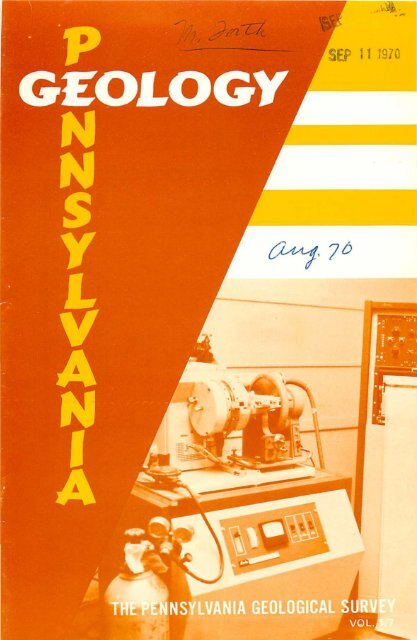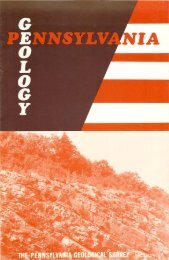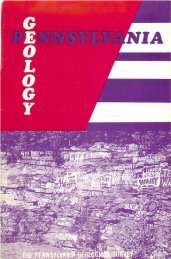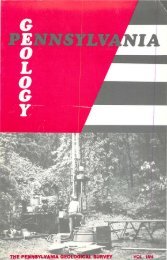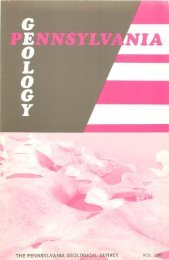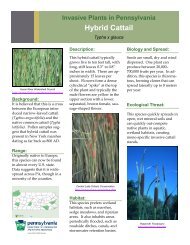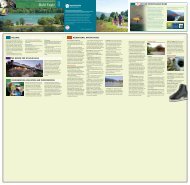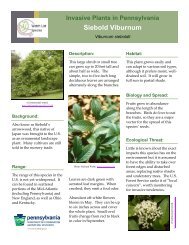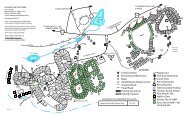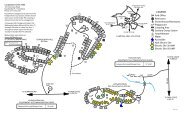DCNR_20027572 - Pennsylvania Department of Conservation and ...
DCNR_20027572 - Pennsylvania Department of Conservation and ...
DCNR_20027572 - Pennsylvania Department of Conservation and ...
Create successful ePaper yourself
Turn your PDF publications into a flip-book with our unique Google optimized e-Paper software.
~. 76
COMMONWEALTH OF PENNSYLVANIA<br />
Raymond P. Shafer, Governor<br />
STATE PLANNING BOARD<br />
Irving H<strong>and</strong>. Executive Director<br />
Topographic <strong>and</strong> Geologic Survey<br />
Arthur A. Socolow, State Geologist<br />
CONTENTS<br />
The State Geologist Reports .......... ............................................................ 1<br />
Geological Research in <strong>Pennsylvania</strong> ......................................................... . 2<br />
Research in Progress ........................................................ ........................... 2<br />
ON THE COVER - New X-ray fluorescence <strong>and</strong> recording instruments enable<br />
the <strong>Pennsylvania</strong> Geological Survey to exp<strong>and</strong> its m ineralogical research program.<br />
PENNSYLVANIA GEOLOGY is published bimonthly by the Topographic<br />
<strong>and</strong> Geologic Survey, Main Capitol Annex, Harrisburg, <strong>Pennsylvania</strong>,<br />
17120.
FROM THE DESK<br />
OF THE<br />
STATE GEOLOGIST . . .<br />
GEOLOGIC RESEARCH<br />
A NEED FOR RELEVANCE<br />
Recognizing that most readers <strong>of</strong> Pennsylvan ia Geology have an interest in<br />
keeping up w it h geologic research in <strong>Pennsylvania</strong>, this issue <strong>of</strong> the bu lletin is<br />
devoted to a comprehensive enumeration <strong>of</strong> all such research brought t o our<br />
att ention. It is pleasing to note t hat <strong>Pennsylvania</strong>'s varied <strong>and</strong> complex geology<br />
continues to attract new research efforts not only by researchers f rom in-state<br />
institutions, but also by researchers far beyond ou r border s. We are also happy<br />
to see t hat so many <strong>of</strong> the current research efforts are f ield projects directed<br />
toward resolving f ield <strong>and</strong> regional geologic problems. In an era when t he<br />
pendu lum has swung so f ar to t he side <strong>of</strong> laboratory research, it is good to see<br />
that so many recognize t hat t here are st il l challenging <strong>and</strong> inspiring problems to<br />
work on in the field.<br />
T he time is now ripe for our geologic researchers to carry t heir efforts t hat<br />
one giant step fa rther which will re late their soph isticated research efforts <strong>and</strong><br />
f indings to man <strong>and</strong> his environ(Tlent. Research geology <strong>and</strong> environmental<br />
geology need not be separate <strong>and</strong> incompatible, as some <strong>of</strong> our traditionalist<br />
colleagues contend. Environmental geology need not be non-scient if ic, even as<br />
research need not be limited to enumeration <strong>of</strong> principles <strong>and</strong> processes.<br />
As members <strong>of</strong> society w ith unique capabilit ies, geologists have a responsibility<br />
to aid man to manage <strong>and</strong> protect his physical environment. It will not<br />
d o for geologists t o be alo<strong>of</strong> <strong>and</strong> disdainful <strong>of</strong> man's needs, for in that case men<br />
<strong>of</strong> lesser ab ilities will fill t he void. Each geulogist should now assess the relevance<br />
<strong>of</strong> his contributions. The <strong>Pennsylvania</strong> Geological Survey is acutely aware <strong>of</strong><br />
geology's impact upon man in <strong>Pennsylvania</strong>. Thus, we encourage <strong>and</strong> support<br />
geologic research that has a relevance to the needs <strong>of</strong> man.
GEOLOGICAL RESEARCH<br />
IN PENNSYLVANIA<br />
1970<br />
INTRODUCTION<br />
The fourteenth annual report <strong>of</strong> Geological Research in <strong>Pennsylvania</strong> has<br />
been compiled by t he <strong>Pennsylvania</strong> Geological Survey as a service to all indivi·<br />
duals interested in geological research on <strong>Pennsylvania</strong>.<br />
The listings are grouped into major categories <strong>of</strong> research to faci litate your<br />
search for information on a particular subject. Project descriptions are printed<br />
where authors supplied us w it h such descriptions. Publications printed during<br />
1969 <strong>and</strong> t he f irst part <strong>of</strong> 1970 are listed alphabetically.<br />
As wit h all compilations, there may have been om issions. If you know <strong>of</strong><br />
anyone who would be interest ed in receiving this annual report, send us their<br />
name so t hat it can be included on our mailing list. Additional copies can be<br />
obtained by writing t o t he Bureau <strong>of</strong> Topographic <strong>and</strong> Geologic Su rvey, Main<br />
Capitol A nnex, Harrisbu rg, Pa. 17120.<br />
RESEARCH IN PROGRESS<br />
AREAL GEOLOGY<br />
HARO LD H. A RNDT, U. S. Geological Survey. Western Middle Anthracite<br />
Field, <strong>Pennsylvania</strong>.<br />
KENT BUSHNEL L, Slippery Rock St ate College. Geology <strong>of</strong> Ohiopyle State<br />
Park.<br />
KENT BUSHNELL, Slippery Rock State College. Geology <strong>of</strong> McConnel ls Mill<br />
State Park.<br />
AVERY A. DRAKE, JR., U.S. Geological Survey. Geology <strong>of</strong> Allentown Qu ad·<br />
rangle. Objectives: To decipher the tect onic history <strong>of</strong> t he area with special<br />
emphasis on the emplacement <strong>of</strong> gravity slides, A lpine nappes, <strong>and</strong> thrust sheets.<br />
2
JACK B. EPSTEIN, U. S. Geological Survey. Geology <strong>and</strong> Mineral Resources <strong>of</strong><br />
the Wind Gap <strong>and</strong> Adjacent Quadrangles.<br />
RODGER T. FAILL <strong>and</strong> RICHARD B. WELLS, <strong>Pennsylvania</strong> Geological Survey.<br />
Geology <strong>and</strong> Mineral Resources <strong>of</strong> the Millerstown 15·Minute Quadrangle. Areal<br />
mapping, stratigraphic description, <strong>and</strong> structural analysis <strong>of</strong> the geology in the<br />
Millerstown 15·minute quadrangle w ith discussion <strong>of</strong> economic resources,<br />
engineering properties <strong>of</strong> the rocks, <strong>and</strong> ground water potential.<br />
DONA LD W. FISHER, New York Geological Survey. Geologic Map <strong>of</strong> New<br />
York · 1970. Five sheets (scale 1 :250,000); also generalized tectonic·<br />
metamorphic map (approx. 1:1 ,500,000) with master legend <strong>and</strong> references on<br />
6th sheet.<br />
GARY B. GLASS, <strong>Pennsylvania</strong> Geological Survey. Geology <strong>and</strong> Mineral Re·<br />
sources <strong>of</strong> the Houtzdale <strong>and</strong> Ramey 7Yl·Minute Quad rangles.<br />
ALBE RT D . GLOVER <strong>and</strong> THOMAS M. BERG, <strong>Pennsylvania</strong> Geological<br />
Survey. Geology <strong>and</strong> Mineral Resources <strong>of</strong> the Northern Half <strong>of</strong> the Penfield<br />
15-Minute Quadrangle.<br />
DONALD M. HOSKINS, Pennsy lvania Geological Survey. Geology <strong>and</strong> Mineral<br />
Resources <strong>of</strong> the Millersburg Quadrangle.<br />
DAVIS M. LAPH AM, <strong>Pennsylvania</strong> Geological Survey. The Serpentinites <strong>and</strong><br />
Associated Rocks <strong>of</strong> Lancaster County, <strong>Pennsylvania</strong>. Structure, lithology,<br />
petrology, mineralogy, geochemistry, <strong>and</strong> economic geology <strong>of</strong> the serpentinites<br />
<strong>and</strong> associated metasediments <strong>of</strong> Southern Lancaster County.<br />
3
RICHARD N ICKELSEN, Bucknell University. Cleavage in Bloomsburg Forma·<br />
tion in Buffalo Valley.<br />
JOHN 0. OSGOOD, Lehigh University. A Paleoenvironmental Study <strong>of</strong> the<br />
A llentown Formation. A stratigraphic ~nd petrographic examination <strong>of</strong> the<br />
Allentown Formation in the area <strong>of</strong> its outcrop between the Delaware <strong>and</strong><br />
Schu ylkill Rivers is to be conducted in ord er to determine the environment <strong>of</strong><br />
deposition, nature <strong>of</strong> the Allentown paleoslope <strong>and</strong> its relationship to the<br />
Reading Prong.<br />
JOHN B. ROEN, U. S. Geological Survey. Geology <strong>of</strong> the Midway Quadrangle,<br />
Southwest <strong>Pennsylvania</strong>.<br />
JOHN B. ROEN, U. S. Geological Survey. Geology <strong>of</strong> the Waynesburg-Oak<br />
Forest Area, Southwest <strong>Pennsylvania</strong> .<br />
S. P. SCHWEINFURTH, U. S. Geological Survey. Geology <strong>and</strong> Mineral Resources<br />
<strong>of</strong> the Claysville-Avella Area. This project is to geologically map two<br />
7 Y:z-minute quadrangles <strong>and</strong> parts <strong>of</strong> two others that join them on the west to<br />
complete geologic mapping to the <strong>Pennsylvania</strong> State Line in Wash ington<br />
County; to eva luat e coal <strong>and</strong> other mineral resources <strong>and</strong> to gather <strong>and</strong> evaluate<br />
data that will aid in underst<strong>and</strong>ing the depositional framework <strong>of</strong> the Upper<br />
<strong>Pennsylvania</strong>n-Lower Perm ian <strong>of</strong> the northern part <strong>of</strong> t he Dunkard Basin, its<br />
structural history, <strong>and</strong> the paleogeographic controls <strong>of</strong> coal accumulation <strong>and</strong><br />
quality.<br />
WI LLIAM D. SEVON, <strong>Pennsylvania</strong> Geological Survey. Geology <strong>and</strong> Mineral<br />
Resources <strong>of</strong> the Northern Half <strong>of</strong> t he Lehighton 15-Minute Quadrangle, Pennsy<br />
lvania. Mapping <strong>and</strong> detailed interpretation <strong>of</strong> t he geology <strong>of</strong> the area.<br />
WALLACE de WITT, JR., U.S. Geological Survey. Hyndman 15-Minute Quadrangle.<br />
Field work this year will be concentrated mainly in the southwest part <strong>of</strong><br />
t he area in the valley <strong>of</strong> Wills Creek, south <strong>of</strong> the town <strong>of</strong> Hyndman <strong>and</strong> along<br />
the A llegheny Front to west <strong>of</strong> Wills Creek.<br />
GORDON H. WOOD, JR., U. S. Geological Survey. Drainage <strong>of</strong> Anthracite<br />
Mines Southern A nthracite Field. A comprehensive study <strong>of</strong> the geo logy <strong>of</strong> the<br />
southern <strong>and</strong> eastern parts <strong>of</strong> the <strong>Pennsylvania</strong> Anthracite region. Project aims<br />
for an underst<strong>and</strong>ing <strong>of</strong> Si lurian through <strong>Pennsylvania</strong>n rocks, the tectonics <strong>of</strong><br />
the Appalach ian Plateau <strong>and</strong> Valley <strong>and</strong> Ridge Provinces in eastern <strong>Pennsylvania</strong>,<br />
<strong>and</strong> the causes, whether sed imentary or structural, that resulted in the formation<br />
<strong>of</strong> anthracite.<br />
4
ECONOMIC GEOLOGY<br />
JACOB FREEDMAN, Franklin <strong>and</strong> Marshall College. Geochemical Exploration<br />
for Mineral Deposits in Lancaster County.<br />
GARY B. GLASS, Pennsylvan ia Geological Survey. Computer Programs in Coal<br />
Geology. Two computer programs have been completed. The first upgrades an<br />
"as received" proximate coal analysis to a moisture-free <strong>and</strong> a moisture <strong>and</strong><br />
ash-free basis; this program also upgrades sulfur contents <strong>and</strong> B.T.U. values. The<br />
second program performs a weighted average for an unlimited number <strong>of</strong><br />
separate proximate analyses; this second program was designed to recombine<br />
proximate ana lyses <strong>of</strong> separate portions (benches) <strong>of</strong> a coal seam into a theoretica<br />
l composite analysis <strong>of</strong> t he entire seam.<br />
KARL V. HOOVER, <strong>Pennsylvania</strong> Geological Survey. Clay-Shale Resources <strong>of</strong><br />
the Pittsburgh Trade Area. Field <strong>and</strong> laboratory evaluation <strong>of</strong> the clay <strong>and</strong> shale<br />
deposits in southwestern <strong>Pennsylvania</strong>.<br />
KARL V. HOOVER, <strong>Pennsylvania</strong> Geological Survey. Atlas <strong>of</strong> <strong>Pennsylvania</strong><br />
Mineral Resources: Part 2 - Clays <strong>and</strong> Shales. Compilation <strong>of</strong> all geologic information<br />
<strong>of</strong> <strong>Pennsylvania</strong>'s clays <strong>and</strong> shales. The publicatio n will be a collection <strong>of</strong><br />
geologic maps, physical property <strong>and</strong> ceramic list data, chemical analyses, <strong>and</strong><br />
summary tables <strong>of</strong> estab lished <strong>and</strong> potential uses.<br />
JOHN W. HOSTERMAN, U. S. Geological Survey. Northern Appalachian Clay<br />
Studies. Field work on this project is complete. A final publication will describe<br />
the underclays <strong>of</strong> Somerset <strong>and</strong> Fayette Counties, Pennsy lvania.<br />
DANA R. KELLEY <strong>and</strong> DAVID DEBOR, <strong>Pennsylvania</strong> Geological Survey.<br />
Subsurface Reservoir Core Analyses. Compi lation <strong>of</strong> core analysis data into<br />
tabulations <strong>and</strong> graphs illustrating porosity, permeability, saturation, density,<br />
sal inity, <strong>and</strong> other core data relationships by unit.<br />
WI L LIAM S. LYTLE, <strong>Pennsylvania</strong> Geological Survey. Crude Oil Reserves <strong>of</strong><br />
<strong>Pennsylvania</strong>. To bring Survey publication M-32 "Crude Oil Reserves <strong>of</strong> <strong>Pennsylvania</strong>"<br />
up-to-date using chemical logs <strong>and</strong> core reports that were not available<br />
when M-32 was written. Considerable addit ional information is now available<br />
which will give more meaning to the reserve estimate.<br />
WILLIAM S. L YTL E, DANA R. KELLEY, WALTER R. WAGNER, LOU IS<br />
HEYMAN, <strong>Pennsylvania</strong> Geological Survey. Oi l <strong>and</strong> Gas Developments in <strong>Pennsylvania</strong><br />
in 1970. A descriptio n <strong>of</strong> the developments during 1970 in search <strong>of</strong> oi l<br />
<strong>and</strong> gas, including high lights, statistics, <strong>and</strong> general oil <strong>and</strong> gas data.<br />
5
WILLIAM S. L YTLE, DA NA R. KELLEY , WALTER R. WA GNER, LOUIS<br />
HEY MAN, Pennsy lvania Geological Survey . The Petroleum Industry <strong>and</strong> the<br />
Future Petroleu m Province in <strong>Pennsylvania</strong>, 1970. A review <strong>and</strong> forecast <strong>of</strong> the<br />
petroleum industry in Pennsy lvania for stimu lating <strong>and</strong> promoting the industry<br />
in the state by demonstrating t he dem<strong>and</strong> <strong>and</strong> need for new hydrocarbon reserv<br />
es <strong>and</strong> the exceptional potent ial for discovery <strong>of</strong> such reserves with improved<br />
technology, <strong>and</strong> new ideas <strong>and</strong> operating met hods.<br />
JAMES P. M INARD , U. S. Geological Survey. Southeast A ppc. lacllian Sediments.<br />
Investigations <strong>of</strong> pot ential minera l depostis, especially heavy metals, in the<br />
Atlant ic Coast al Plain <strong>and</strong> eastern Triassic basins.<br />
JOH N SLA UGHTER <strong>and</strong> H. LAWRENCE McKAGUE, Rutgers University.<br />
Genesis <strong>of</strong> t he Stratiform Copper Deposits <strong>of</strong> t he Catskill Formation in Northeast<br />
ern <strong>Pennsylvania</strong>.<br />
WALTER R. WAGNER <strong>and</strong> DANA R. KELLEY , <strong>Pennsylvania</strong> Geological<br />
Survey. Surface Middle Devonian (Onondaga ) Econom ic Stratigraphy <strong>of</strong> Western<br />
<strong>Pennsylvania</strong>. To erect a stratigraphic framework f or Upper Devonian,<br />
Mississippian <strong>and</strong> Pottsville (<strong>Pennsylvania</strong>n ) rocks <strong>of</strong> west ern <strong>Pennsylvania</strong>. The<br />
work is to be completed in three phases. Phase I, showing major subdivisions <strong>of</strong><br />
Upper Devonian Rocks, is published (Pa. Geol. Survey PR 178 ). Phase II, in<br />
process, consist s <strong>of</strong> a network <strong>of</strong> cross sections tying subsurface data (geophysical<br />
well logs) into su rface sections. The sections will show hydrocarbon<br />
reservoirs, gross stratigraphic changes, <strong>and</strong> posit ion <strong>of</strong> fresh water, coal, limestone,<br />
clay <strong>and</strong> other major resou rces. Phase Ill - reg ion
NORMAN K. FLINT <strong>and</strong> JAMES V. HAMEL, Universi ty <strong>of</strong> Pittsburgh. Analysis<br />
<strong>and</strong> Design <strong>of</strong> Highway Cu ts in Rock: A Slope Stabi lity Study on Interstate<br />
Routes 279 <strong>and</strong> 79 near Pittsburgh, Pa.<br />
JOHN R. HARR IS <strong>and</strong> MARSHA LL A. NELSON, U.S. A rmy Engineer District,<br />
Philadelphia. Engineering Geology <strong>of</strong> Blue Marsh Reservoir. En gineering geology<br />
<strong>of</strong> the entire project including foundation studies for design recommendations<br />
<strong>and</strong> maximum use <strong>of</strong> local materials f or construction pu rposes; env ironmental<br />
studies for recreation purposes <strong>and</strong> for quali ty <strong>of</strong> water. Ordovician geology<br />
highlighted.<br />
KARL V. HOOVER, <strong>Pennsylvania</strong> Geological Survey, RICHARD HOWE <strong>and</strong><br />
DAVID REIDENOUR, <strong>Pennsylvania</strong> <strong>Department</strong> o f Highways. Engineering<br />
Properties <strong>of</strong> Shales for Highway Gra nular Material Use. Investigations <strong>of</strong><br />
engi neering properties o f shales for use as a granular material for highway construction.<br />
A major endeavor <strong>of</strong> the project is to establish testing st<strong>and</strong>ards for<br />
selecting suitable shales.<br />
R. G. LAZOR <strong>and</strong> A. J. DEPMAN, U. S. Army Engineer District, Ph iladelphia.<br />
Final Foundation Report - Beltzv ille Dam, Leh ighton , <strong>Pennsylvania</strong>.<br />
Final<br />
foundation report high lighting structural geology encountered during construction<br />
<strong>of</strong> Beltzville Dam; details foundation treatment includi ng pressure grouting,<br />
dental treatment, <strong>and</strong> high velocity concrete treatment <strong>of</strong> abutment area.<br />
Foundation rock is fossi liferous Devonian Mahan tango Formation; axis <strong>of</strong> dam<br />
<strong>and</strong> pertinent structures located normal to axis <strong>of</strong> Lehighton anticline.<br />
ENVIRONMENTAL<br />
GEOLOGY<br />
WILLIAM B. FERGUSSON, Villanova Universit y. Geo logica l Approach to Man's<br />
Environment. Environmental problems rela ted to the geology o f the area<br />
illustrated w it h case studies from the author's experiences.<br />
ALAN R. GEYER <strong>and</strong> WI LLIAM G. McGLADE, <strong>Pennsylvania</strong> Geological<br />
Survey. Environmental Geology for L<strong>and</strong>-Use Planning. Guide to the value <strong>of</strong><br />
geology in all phases <strong>of</strong> l<strong>and</strong>-use planning, design, <strong>and</strong> construction.<br />
7
MARY E. HORNE, Pennsylvan ia Geo logical Survey. Environmental Geology <strong>of</strong><br />
the Greater York Area. This study involves the incorporation <strong>of</strong> basic geologic<br />
mapping w ith soils mapping, ground water data, mineral resource data, <strong>and</strong><br />
engineering characteristics <strong>of</strong> rock formations w it h the applica tion <strong>of</strong> these data<br />
to present l<strong>and</strong> use in the area <strong>and</strong> to projected growth needs.<br />
DANA R. KE L LEY, <strong>Pennsylvania</strong> Geological Survey. Clay-shale Related L<strong>and</strong>slides<br />
in t he Pittsburgh, <strong>Pennsylvania</strong> Area. As a means <strong>of</strong> infc-ming industry,<br />
government, <strong>and</strong> the public <strong>of</strong> the serious l<strong>and</strong>slide hazards existing in <strong>and</strong> about<br />
Pittsburgh, a short compilation <strong>of</strong> existing knowledge <strong>and</strong> causes <strong>of</strong> these slides<br />
is being prepared, including a map <strong>of</strong> sl ides <strong>of</strong> record, general cross sections<br />
il lustrat ing stra t igraphic variation in hazardous zones <strong>and</strong> selected illustration s,<br />
d iagrams, <strong>and</strong> graphs.<br />
WILLIAM G. McG LA D E, <strong>Pennsylvania</strong> Geologica l Survey. Environmental<br />
Geology <strong>of</strong> t he Harrisburg Metropolitan Area. Comp ile, reinterpret <strong>and</strong> add basic<br />
geology. ground water, minera l resource <strong>and</strong> engineering data for the Harr isburg<br />
Metropolitan area. The purpose <strong>of</strong> this study is to apply geological principles,<br />
interpretation <strong>of</strong> data toward an underst <strong>and</strong>ing <strong>of</strong> the subject area that wil l be<br />
immed iately usefu I to planner s, engineers, government <strong>of</strong>ficia ls, <strong>and</strong> the general<br />
public.<br />
WILLIAM G. McG LADE, J.P. WI LSHUSEN <strong>and</strong> A. R. GEYER, Pennsylvan ia<br />
Geological Survey. Engineering Characteristics - Rocks <strong>of</strong> <strong>Pennsylvania</strong>. Project<br />
covers geologic, engineering, <strong>and</strong> ground wa ter characteristics <strong>of</strong> each rock<br />
formation described on the 1960 State Geologic Map. Material will be presented<br />
in chart f orm <strong>and</strong> is intended as a supplement to t he State Geologic Map.<br />
NEILSON RUDD, Geo-Engineering Laboratories, Inc. The Feasibility <strong>of</strong> Subsurface<br />
Liqu id Waste Disposa l in <strong>Pennsylvania</strong>. The project consists <strong>of</strong> three<br />
phases : 1) a comprehensive review <strong>of</strong> the principles <strong>of</strong> deep well disposal, 2) a<br />
discussion <strong>of</strong> techniques <strong>and</strong> gu idelines for site select ion , evalu ation, <strong>and</strong> operational<br />
monitoring, <strong>and</strong> 3) a reg ional survey <strong>of</strong> potential d isposa l reservoirs within<br />
the Commonwealt h <strong>of</strong> <strong>Pennsylvania</strong>.<br />
S. F. THOUMSIN <strong>and</strong> J. R. N IEHEISEL, U.S. A rmy Engineer District Philadelphia.<br />
Delaware River Estuary - Nature, Source <strong>and</strong> Cause <strong>of</strong> Shoaling. Part Il l <strong>of</strong><br />
a seven part study on Long Range Disposal Areas for Delaware River Shoals.<br />
Purpose <strong>of</strong> study is to provide basic data on t he physio-chem ical propert ies <strong>of</strong><br />
princi pal shoal areas, the sources, <strong>and</strong> mechan isms causing their formation. In<br />
clu e course extensive petrologic studies are to be made. In addition the potential<br />
agricultural va lu e <strong>of</strong> the sediments was studied.<br />
8
GENERAL GEOLOGY<br />
ERNST CLOOS, Johns Hopkins University. Geology <strong>of</strong> the Thomasville Area,<br />
York County. This will complete a study which began in 1935 <strong>and</strong> continued<br />
since then. It includes Kinzers <strong>and</strong> Vintage stratigraphy at Thomasville, struc·<br />
tural geology, some economics, <strong>and</strong> historical development. Dolomite <strong>and</strong><br />
dolomitization <strong>and</strong> a few fossi ls w ill be included.<br />
A LAN R. GEYER, <strong>Pennsylvania</strong> Geological Survey. A Geologic Guide to<br />
Rickett's Glen State Park. A geologic description <strong>of</strong> Rickett's Glen State Park<br />
with special emphasis on the origin <strong>of</strong> the waterfalls.<br />
DONAL D HOFF, <strong>Pennsylvania</strong> Historical <strong>and</strong> Museum Commission. Planning <strong>of</strong><br />
Permanent Earth Science Exhibits for the William Penn Memorial Ex hibits.<br />
BION H. KENT, U.S. Geological Survey. Geology <strong>of</strong> the Mather-Garards Fort<br />
Area, Southwestern <strong>Pennsylvania</strong>. Project objectives include (a) geologic quadrangle<br />
mapping at 1:24,000 scale; (b) sedimentological studies, primarily <strong>of</strong><br />
lith<strong>of</strong>acies trends <strong>and</strong> their effects upon associated coal beds; <strong>and</strong> (c) evaluation<br />
<strong>of</strong> coal resources, primarily in the Pittsburgh, Sewickley, <strong>and</strong> Waynesburg coal<br />
beds.<br />
DAVIS M. LAPHAM <strong>and</strong> ALAN R. GEYER, <strong>Pennsylvania</strong> Geological Survey.<br />
Common Rocks <strong>and</strong> Minerals <strong>of</strong> <strong>Pennsylvania</strong>. A complete rewrite <strong>of</strong> the<br />
Survey's Education Series No. 1 booklet.<br />
WILLIAMS. LYTLE <strong>and</strong> LILLIAN HEEREN, <strong>Pennsylvania</strong> Geological Survey.<br />
Principal Crude Oil, Product <strong>and</strong> Natural Gas Pipelines. Brings the pipelines map<br />
up-to-date showing changes, refineries <strong>and</strong> gas storage fields.<br />
WILLI AM G. MeG LA DE, <strong>Pennsylvania</strong> Geological Survey. Pennsylvan ia Trail <strong>of</strong><br />
Geology - The Gr<strong>and</strong> Canyon <strong>of</strong> <strong>Pennsylvania</strong>. A geological description <strong>of</strong> the<br />
<strong>Pennsylvania</strong> Gr<strong>and</strong> Canyon tor the lay reader.<br />
GEOCHEMISTRY<br />
DONALD LANGMU IR <strong>and</strong> DONALD 0. WH ITTEMORE, The Pennsy lvania<br />
State University. fhe.Nat ure <strong>of</strong> Yellow-boy Precipitates from Acid-m ine Waters.<br />
Exam ination <strong>of</strong> the physical <strong>and</strong> chemical properties <strong>of</strong> f erric oxyhydroxides<br />
precipitated by oxidation <strong>and</strong>/ or hydrolysis <strong>of</strong> acid-m ine waters.<br />
9
DAVIS M. LAPHAM, <strong>Pennsylvania</strong> Geological Survey. Isotopic Dating <strong>of</strong><br />
Precambrian Schists, Erie County. Correlation <strong>and</strong> significance <strong>of</strong> K-Ar <strong>and</strong><br />
Rb-Sr age dates on Precambrian metasediments from drill cores beneath the<br />
Plateau.<br />
DAVIS M. LA PH AM, S. ROOT, <strong>and</strong> D. MACLACHLAN, <strong>Pennsylvania</strong> Geological<br />
Survey. Isotopic Dating in the Reading Prong <strong>of</strong> <strong>Pennsylvania</strong>. Correlat<br />
ion <strong>and</strong> Significance <strong>of</strong> K-Ar dates in the <strong>Pennsylvania</strong> Reading Prong.<br />
DAVIS M. LAPHAM <strong>and</strong> S. ROOT, <strong>Pennsylvania</strong> Geological Survey. Isotopic<br />
Dating in t he Blue Ridge <strong>of</strong> <strong>Pennsylvania</strong>. Correlation <strong>and</strong> sign ificance <strong>of</strong> U-Pb,<br />
K-Ar, <strong>and</strong> Rb-Sr dates in the <strong>Pennsylvania</strong> Blue Ridge.<br />
DAVIS M. LA PH AM <strong>and</strong> S. ROOT, Pen nsy lvania Geological Survey. Isotopic<br />
Dating <strong>of</strong> Faulting in the Great Valley <strong>of</strong> <strong>Pennsylvania</strong>. Signif icance <strong>of</strong> K-Ar<br />
dates on fault gouge <strong>and</strong> enclosing sediments in the <strong>Pennsylvania</strong> Great Valley.<br />
H. LAWR ENCE MCKAGUE, Rutgers University. T race Element Distribution in<br />
State Line Serpentinite.<br />
ARTHUR W. ROSE <strong>and</strong> DAVID C. HERRICK, The <strong>Pennsylvania</strong> State University.<br />
Geochemistry <strong>of</strong> the Cornwall Iron Ore Deposit. The main emphasis <strong>of</strong> the<br />
project is on oxygen isotope abundance, supplemented by considerable chemical<br />
<strong>and</strong> mineralogical work, in order to interpret temperature <strong>and</strong> other conditions<br />
<strong>of</strong> ore formation, <strong>and</strong> processes <strong>of</strong> ore formation.<br />
A RTHUR W. ROSE <strong>and</strong> ROBERT C. SM ITH II, The <strong>Pennsylvania</strong> State University.<br />
Geochemistry <strong>of</strong> Triassic Diabase. The abu ndance <strong>of</strong> trace <strong>and</strong> major<br />
elements has been determined in about 100 chilled border samp les <strong>and</strong> in several<br />
su ites <strong>of</strong> samples through sheets. The results are being used to better underst<strong>and</strong><br />
the origin <strong>of</strong> t he diabase magma <strong>and</strong> the associated ore deposits.<br />
A RTHUR W. ROSE, JAMES McNEAL, <strong>and</strong> M. L. KE ITH, The <strong>Pennsylvania</strong><br />
State University. Geochemistry <strong>of</strong> <strong>Pennsylvania</strong> Stream Sediments. Present work<br />
is concentrated on the abundance <strong>of</strong> mercury in stream sed iments, <strong>and</strong> on the<br />
partition <strong>of</strong> Cu, Zn, Ni, Co, <strong>and</strong> Pb between exchange sites, organic matter, iron<br />
oxides, s<strong>and</strong>, silt <strong>and</strong> clay fractions. Statistical techniques are being used to<br />
improve resolution <strong>of</strong> anomalies in a large group <strong>of</strong> samples covering the southeastern<br />
part <strong>of</strong> the state.<br />
F. K. SZUCS, Slippery Rock State College. Correlation <strong>and</strong> Absolute Age<br />
Determination <strong>of</strong> the Slippery Rock Till. Exposures <strong>of</strong> the Slippery Rock Till<br />
were correlated by using neutron activation techniques.<br />
10
PETER W. WEIGAND, University <strong>of</strong> North Carolina. Geochemi stry <strong>of</strong> <strong>Pennsylvania</strong><br />
Triassic (?) Dolerite Dikes. This project is part <strong>of</strong> a larger study concern ed<br />
with the geochemistry <strong>of</strong> t he eastern North A merican Triassic (?) dolerite dikes.<br />
GEOMORPHOLOGY<br />
DONA LD R. COATES, State University <strong>of</strong> New York at Binghamton. Terrain<br />
Comparison <strong>of</strong> the Glaciated <strong>and</strong> Non-Glaciated Appalachian Plateau. This is<br />
largely a quantitative <strong>and</strong> computergraphic morphometry st udy <strong>of</strong> the 1 :62,500<br />
sca le topographic maps in a 20,000 square mi le reg ion.<br />
RICHA RD A. MARTI N, Millersville St ate College. Devil's Race Course Boulder<br />
Field, Dau phin County.<br />
WILLIAM B. WHITE, The <strong>Pennsylvania</strong> State University. Caves <strong>of</strong> <strong>Pennsylvania</strong>.<br />
Progress has been made in compiling a new comprehensive catalog <strong>of</strong> the caves<br />
<strong>of</strong> Pennsy lva nia. Work on the western portion <strong>of</strong> the state is complete <strong>and</strong> data<br />
for the Piedmont <strong>and</strong> Great Valley are nearing final form.<br />
GEOPHYSICS<br />
RONALD R. HA RTMA N, Aero Service Corporation. Development <strong>of</strong> a digital<br />
recording-computer contouring package for radioactivity su rvey data. Aero Service<br />
Corporation has recently completed the installation <strong>of</strong> a new airborne<br />
geophysical survey package in an Aero Comm<strong>and</strong>er aircraft. The package<br />
includes a magnetometer with a sensit ivity <strong>of</strong> 1/ 10 gamma, a scint illation<br />
counter with spectral channels to detect rad iation in the uranium, potassium <strong>and</strong><br />
thorium emission ranges, <strong>and</strong> a digital recording syst em which records<br />
barometric <strong>and</strong> terrain clearance altitudes as well as the geophysical data. At the<br />
heart <strong>of</strong> the system is a doppler navigation instal lation which provides a ground<br />
distance base for t he recording <strong>of</strong> all data. The system is designed for mineral<br />
exploration work.<br />
PETER M. LAVIN, The <strong>Pennsylvania</strong> State University. Iron Ore Geophysics.<br />
The pu rpose <strong>of</strong> the stu dy is to search for characteristic geophysical responses<br />
which can be used in distingu ishing between aeromagnetic anomalies in the<br />
Triassic Basin <strong>of</strong> southeastern <strong>Pennsylvania</strong> due t o massive magnetite deposits<br />
(<strong>of</strong> possible econom ic importance) <strong>and</strong> anomalies due to diabase intrusives<br />
(disseminated magnetite).<br />
11
GLACIAL GEOLOGY<br />
DONA LD R. COATES, State University o f New York at Binghamton. Mastodon<br />
Bone Age <strong>and</strong> Geomorphic Relations in the Susquehanna Valley. A massive<br />
20-inch bone has been identified as a pelvic fragment <strong>of</strong> a mastodon, Mammut<br />
americanus, <strong>and</strong> has y ielded a Carbon-14 date <strong>of</strong> 13,320 - 200 yrs. B.P. The<br />
bone was discovered in a gravel pit, 11 feet below the gound in a terrace along<br />
the valley <strong>of</strong> the Chemung River.<br />
GEORGE W. CROWL, Ohio Wesleyan University. Pleist ocene Geology <strong>of</strong> the<br />
Delaware Valley, Matamoras to Shawnee on Delaware.<br />
DEN I S E. MARCH AND, Bucknell University. Pre-Wisconsin Pleistocene<br />
Stratigraphy <strong>and</strong> Chronology <strong>of</strong> the Central Susquehanna Region .<br />
WILLIAM D. SEVON, <strong>Pennsylvania</strong> Geologica l Su rvey. Investigation <strong>of</strong> charac·<br />
teristics <strong>of</strong> a small boulder f ield which is adjacent to the Wisconsin 't erminal'<br />
moraine <strong>and</strong> overlies Wisconsi n outwash sediments.<br />
STAN LEY M. TOTTEN, Hanover College. Fossil Beetles f rom Wisconsinan Peat,<br />
Titusville, Pennsy lvania. A 40,000 year old peat deposit at Titusville, Pa., has<br />
yielded the remains <strong>of</strong> 750 individual beetles, many <strong>of</strong> which have been<br />
identified to genus <strong>and</strong> species. The species identified have a northern distribut<br />
ion <strong>and</strong> are found typically in the Hudsonian Zone <strong>of</strong> Canada.<br />
HYDROLOGY<br />
ALBERT E. BECHER <strong>and</strong> WALTER S. WETTERHA LL, U. S. Geological<br />
Survey. Urban <strong>and</strong> Rural Ground Wat er Hydrology in the Northern Part <strong>of</strong> the<br />
Cumberl<strong>and</strong> Va lley, <strong>Pennsylvania</strong>.<br />
JAMES DIAZ <strong>and</strong> RICHA RD R. PAR IZE K, Geo-T echnical Services <strong>and</strong> The<br />
12
<strong>Pennsylvania</strong> State University. Effects <strong>of</strong> Spray Irrigation <strong>of</strong> Sewage Effluent on<br />
Ground Wat er. Soil test s <strong>and</strong> ground wa ter data from exploration holes in deep<br />
residual soils (Wissah ickon) at the site indicate suitable condit ions for spray<br />
irrigation <strong>of</strong> effluent from aerated sewage lagoons (now under construction).<br />
Irrigat ion rates, nutrient content, growth rate <strong>of</strong> crops <strong>and</strong> nursery stock, eff ects<br />
on surface <strong>and</strong> ground water will be monitored <strong>and</strong> recorded for several years.<br />
JAMES DIAZ <strong>and</strong> RI CHA RD R. PARI Z EK, Geo-Technical Services <strong>and</strong> The<br />
<strong>Pennsylvania</strong> Stat e University. Investigation <strong>of</strong> Safe-yield <strong>of</strong> Aquifer. A n investigation<br />
using electrical analog modeling techniques <strong>and</strong> digital computer will be<br />
made this summer to pred ict the susta ined safe-yield <strong>of</strong> an aquifer <strong>of</strong> Cockeysville<br />
Marble surrounded on three sides by Wissahickon schist.<br />
MARl LYN GINSBERG, State University <strong>of</strong> New York at Binghamt on. Relationship<br />
between the Geo logy <strong>and</strong> the Geohydrology <strong>of</strong> the Triassic Basin in <strong>Pennsylvania</strong>.<br />
JERRA LD R. HOLLOWELL <strong>and</strong> HAR RY E. KOESTER, U. S. Geological<br />
Survey. Ground Water Resources <strong>of</strong> Lackawa nna County. Project is to evaluate<br />
<strong>and</strong> appraise the ground wat er resources in t he county.<br />
DONA LD LANGMUIR <strong>and</strong> WILLIAMS. SANNER, JR., The <strong>Pennsylvania</strong> State<br />
University. Nitrogen <strong>and</strong> Phosphorus Variations in Ground Wat er beneath Farm<br />
L<strong>and</strong>, Mahantango Wat ershed, <strong>Pennsylvania</strong>. Invest igations <strong>of</strong> cont rols on <strong>and</strong><br />
variations in amounts <strong>of</strong> n itrogen <strong>and</strong> phosphorus in ground wat er in a part <strong>of</strong><br />
the Mahanta ngo Wat ershed, Pennsylvan ia.<br />
DONALD LA NGMUIR <strong>and</strong> ROG ER L. JACOBSON, The <strong>Pennsylvania</strong> State<br />
University. Hydrogeochemistry <strong>of</strong> Ground Water in Carbonate Rocks. Study <strong>of</strong><br />
how grou nd water in a carbonate rock terrane is related to gas-so lution-minera l<br />
reactions, pollut ion, <strong>and</strong> hydrogeology.<br />
DONALD LANGMUI R, RICHA RD R. PAR IZEK, <strong>and</strong> M ICHA EL A. A PGA R,<br />
The <strong>Pennsylvania</strong> State University. The Chemical Interaction <strong>of</strong> Sanitary<br />
L<strong>and</strong>fill Leachate w ith Unsaturat ed Soil in a Carbonate Rock Terrane. Invest igat<br />
ion <strong>of</strong> the det ailed physical-chem ical processes which account for renovation <strong>of</strong><br />
l<strong>and</strong>fill-leachate in a so il, <strong>and</strong> the establish ment <strong>of</strong> site-selection criteria for<br />
l<strong>and</strong>fills in carbonate-rock terranes in Pennsy lvania. A n improvement in leachat e<br />
quality occu rs within unsatu rat ed soil beneath l<strong>and</strong>fills. Serious ground water<br />
pollution by leachates will occur if l<strong>and</strong>fill materials come in contact wit h<br />
ground water.<br />
ORV ILLE B. LLOYD, J R. <strong>and</strong> DOUGLAS J. GROW ITZ, U. S. Geological<br />
Survey. Ground Water Resou rces <strong>of</strong> Central <strong>and</strong> Sout hern York County. The<br />
investigation w ill evaluate t he water-bearing <strong>and</strong> wat er-quality charact eristics <strong>of</strong><br />
the major bedrock units in t he area <strong>of</strong> study.<br />
13
THOMAS G. NEWPORT <strong>and</strong> JOHN GALLA HER, U. S. Geological Survey.<br />
Summa ry reports <strong>of</strong> the ground-water resources <strong>of</strong> each county in <strong>Pennsylvania</strong>.<br />
WI LLIAM B. WHITE <strong>and</strong> HENRY W. RAUCH, The <strong>Pennsylvania</strong> State University.<br />
So lution Kinetics <strong>of</strong> Carbonate Rocks. Empirical rates <strong>of</strong> solutions for<br />
various carbonate rocks in water at one atm C02 pressure have been determined<br />
in the laboratory. The variation in solution rate between rock lithologies<br />
correlates with the amount <strong>of</strong> solution cav ity development observed in these<br />
rocks in the field.<br />
WILLIAM B. WHITE <strong>and</strong> EVAN T . SH UST ER, The <strong>Pennsylvania</strong> Stat e University.<br />
Chemistry <strong>of</strong> Limest one Spring Waters. The seasonal fluctuations in the<br />
chemistry <strong>of</strong> limestone spring waters reflect the type <strong>of</strong> aquifer system feed ing<br />
the spring. Large f luctuations imply conduit systems with f ast flow-through<br />
t imes. Small f luctuations imply diffuse f low systems. Most spring waters are<br />
found to be under-satu rated with respect to CaC03.<br />
CHARLES R. WOOD, U.S. Geological Survey. Ground-water Resources <strong>of</strong> the<br />
Clarion River <strong>and</strong> Red bank Creek Basins. Ground-water quality <strong>and</strong> availability<br />
will be studied with special emphasis on quality problems related to mining <strong>and</strong><br />
active <strong>and</strong> ab<strong>and</strong>oned oil <strong>and</strong> gas wells.<br />
IGNEOUS AND<br />
METAMORPHIC GEOLOGY<br />
W. A. CRAWFORD <strong>and</strong> P. G. RO BE LEN, Bryn Mawr Coll ege. Pet rological <strong>and</strong><br />
Chemical Variations <strong>of</strong> the Honeybrook A northosite.<br />
MINERALOGY<br />
DAVIS M. LA PH AM <strong>and</strong> ALAN R. GEYER, Pen nsylvania Geological Survey.<br />
Mineral Collecting in Pennsylvan ia. A cont inuing project to describe minerals<br />
<strong>and</strong> mineral local ities in Pennsy lvania.<br />
WILLI AM B. WHITE, The <strong>Pennsylvania</strong> State University. Infrared Spectra <strong>of</strong><br />
Hydrous Carbonate Minerals. Infrared spectra have been measured on the<br />
hydrous carbonate minerals artinite, nesquehonite, <strong>and</strong> hydromagnesite. The<br />
spectra were used to determine the posit ions <strong>and</strong> hydrogen bonding <strong>of</strong><br />
hydroxyl ions <strong>and</strong> water mo lecules. Artinite <strong>and</strong> nesquehonite have similar structures<br />
<strong>and</strong> spectra results are consistent with the published structure <strong>of</strong> artinite.<br />
Hydromagnesite has a quite different structu re based on hydroxide layers.<br />
14
PALEONTOLOGY<br />
DONALD BAI RD, Pri nceton University. Addit ions to t he Vertebrate Fauna <strong>of</strong><br />
t he Upper Kittanning Coal (m id-<strong>Pennsylvania</strong>n) <strong>of</strong> Cannelton, Beaver County,<br />
<strong>Pennsylvania</strong>. A search <strong>of</strong> the old Survey collections at t he William Penn<br />
Memorial Museum has y ielded a specimen <strong>of</strong> t he coelacanth fish Rhabdoderma<br />
elegans which seems to be t he first record <strong>of</strong> a Carboniferous coelacanth in<br />
<strong>Pennsylvania</strong>. A search <strong>of</strong> the Princeton paleobotanical collection produced a<br />
specimen <strong>of</strong> the ubiquitous fresh-water shark Xenacanthus compressus. Both<br />
were collected by mine-owner I. F. Mansfield at Cannelton about 1877.<br />
ROGER L. BAT T EN <strong>and</strong> R. H. RO LLI NS, American Museum <strong>of</strong> Natural<br />
History. Conemaugh-A llegheny Gastropods <strong>and</strong> Paleo-Ecology.<br />
ST IG M. BERGST ROM, T he Ohio State University. Conodont Biostratigraphy<br />
<strong>of</strong> the Middle Ordovician <strong>of</strong> <strong>Pennsylvania</strong>.<br />
A LBERT A. BERTI, University <strong>of</strong> Western Ontario. Pollen <strong>and</strong> Seed A nalysis <strong>of</strong><br />
t he T itusv ille Section (Mid-Wisconsin), Titusville, Pa.<br />
PET ER W. BRETSKY, K. W. FLESSA, <strong>and</strong> S. S. BRETSKY, Northwestern<br />
University. Ecology <strong>of</strong> Lat e Ordovician Benthic Communities. The investigation<br />
was a study <strong>of</strong> t he paleoeco logy <strong>of</strong> the foss iliferous beds at the top <strong>of</strong> t he<br />
Reedsville <strong>and</strong> Mart insburg Formations. The area covered extended from central<br />
Pennsy lvania to northern Tennessee.<br />
JOHN A. CLENDEN ING, Pan A merican Petroleum Cor p_ Sporological Evidence<br />
on t he Geological Age <strong>of</strong> the Dunkard Strat a in the Appalachian Basin. Study <strong>of</strong><br />
fossil spores <strong>and</strong> pollen f rom throughout the Dunkard strata su bstant iat es an<br />
Upper <strong>Pennsylvania</strong>n rather than a Permian Age for the entire sequence <strong>of</strong> strata.<br />
CHRIST OPHER J. D UR DE N, Texas Memorial Museum. Systematics <strong>and</strong><br />
Biostrat igraphy <strong>of</strong> the Insects, Arachnids, <strong>and</strong> other Terrestrial Arthropods <strong>of</strong><br />
t he <strong>Pennsylvania</strong>n. European sub-epochs (Autunian A. Stephanian C & A-B,<br />
Westphalian D, C-D, C, B, A, <strong>and</strong> Namu rian C) recognized in both bituminous &<br />
Ant hracite f ields on the basis <strong>of</strong> distribution <strong>of</strong> blattoid genera. "Cassville"<br />
f auna located in the Southern Anthrac ite Field in ro<strong>of</strong> Black Mine Vein.<br />
"Cassville" genera occur in European Aut. A ., not in Stephanian.<br />
15
NI L ES E LD REDG E, American Museum <strong>of</strong> Natural History. Middle Devonian<br />
Tr ilobites.<br />
HENRY FAUL, CARO L FA UL, <strong>and</strong> others, University <strong>of</strong> <strong>Pennsylvania</strong>. Beltzville<br />
Reservoir Paleontologica l Salvage. We are making a reference collection <strong>of</strong><br />
fossils f rom t he well known Mahantango Formation locality along Pohopoco<br />
Creek which will be f looded by t he Beltzville Dam Reservoir.<br />
WI LLI AM H . G IL LESP I E, West Virginia University <strong>and</strong> JOHN A .<br />
CLENDENI NG, Pan American Petroleum Corp. Age <strong>of</strong> Dunkard Group,<br />
Appalachian Basin.<br />
A LBE RT L. GUBER, The <strong>Pennsylvania</strong> State University. Paleoeco logy <strong>of</strong><br />
Col umbiana.<br />
A LBERT L. GUBER <strong>and</strong> LYNN BRANT, The <strong>Pennsylvania</strong> State University.<br />
Paleoecology <strong>of</strong> Brush Creek.<br />
JON D. INNERS, <strong>Pennsylvania</strong> <strong>Department</strong> <strong>of</strong> Highways. Stratigraphy <strong>and</strong><br />
Paleontology <strong>of</strong> the Onesque Thaw St age in Pennsy lvania.<br />
RICHARD LUND, University <strong>of</strong> Pittsburgh. Fossi l Fishes from Sout hwest ern<br />
<strong>Pennsylvania</strong>. Detai led paleontologic work with very close stratigraphic control,<br />
upon vertebrate-bearing beds from the Allegheny to the Du nkard, is in progress.<br />
A new genus <strong>of</strong> Lungfish, with a species is being described, as well as new species<br />
<strong>of</strong> f resh-water shark. Some underst<strong>and</strong>ing <strong>of</strong> stratigraphic succession <strong>of</strong> faunas is<br />
emerging.<br />
WILLIAM H. PARSONS <strong>and</strong> DOUGLAS SCHAMEL, A llegheny College.<br />
Palynology <strong>of</strong> Peat <strong>and</strong> Lake Deposits <strong>of</strong> Crawford County, <strong>Pennsylvania</strong>. We are<br />
comparing pollen stratigraphy <strong>of</strong> lake bed sediments w it h stratigraphy <strong>of</strong><br />
selected int erstad ial <strong>and</strong> postglacial peat deposits <strong>of</strong> eastern Crawford County.<br />
HARO LD B. ROLLI NS, RICHA RD LUND, JACK DONAHUE, <strong>and</strong> ROGER<br />
BATTEN, University <strong>of</strong> Pittsburgh. Community Structure <strong>and</strong> Evolution in the<br />
Conemaugh <strong>of</strong> t he Appalachian Basin.<br />
CRAIG D. SHAAK, University <strong>of</strong> Pittsbu rgh. Brush Creek Limestone (<strong>Pennsylvania</strong>n)<br />
within t he Appalachian Basin. This Ph.D. thesis is designed to establish<br />
lateral <strong>and</strong> vertical spec ies diversif ication in t he Brush Creek Limestone (<strong>Pennsylvania</strong>n)<br />
within t he Appalachian Basin. The goal <strong>of</strong> t he investigati on is t o<br />
reconstruct t he fossil communit ies <strong>and</strong> their variations with respect to paleoenvironments.<br />
16
KEITH S. THOMSON, Yale Peabody Museum. A new genus <strong>and</strong> species <strong>of</strong><br />
lobe-fin fish from t he Upper Devonian (Oswayo Formation) <strong>of</strong> Clinton <strong>and</strong><br />
McKean Counties, Hyneria lindae, throws new light on t he origin <strong>of</strong> t he<br />
amphibians because it "shows a closer general resemblance to the Amphibia than<br />
any other known rhipidistian."<br />
SEDIMENTARY<br />
PETROLOGY<br />
ROBERT W_ ADAMS, S.U.N.Y. College at Brockport. Compaction in Carbonates-<br />
Mechanisms <strong>and</strong> Significance.<br />
WILLIAM R. KAISER, Johns Hopkins University. Sedimentology <strong>of</strong> the Mahant<br />
ango Formation. Determine the geometry <strong>of</strong> t he Montebel lo S<strong>and</strong>stone Member<br />
<strong>and</strong> to unravel the coarsening-upward cycles. Investigate regional lithologic<br />
changes within Mahantango. Detailed petrology <strong>of</strong> the coarsening-upward cycles.<br />
JOHN B. ROE N, U. S. Geological Survey. Petrology <strong>of</strong> the Pittsburgh S<strong>and</strong> stone<br />
in the Northern Half <strong>of</strong> the Dunkard Basin.<br />
A LLA N M. THOMPSON, University <strong>of</strong> Delaware. Upper Ordovician Clastic<br />
Wedge Deposits. Active parts <strong>of</strong> the project include two areas: (1) delineation <strong>of</strong><br />
depositional environments <strong>and</strong> tectonic styles associated with the transition<br />
from flysch t o molasse sed imentation in the Upper Ordovician Taconic clastic<br />
wedge deposits <strong>of</strong> the Reedsville Formation; <strong>and</strong> (2) color boundaries <strong>of</strong> the<br />
Jun iata Formation. This area relates to redefinition <strong>of</strong> the major stratigraphic<br />
units present in the Upper Ordovician.<br />
ROGER G. WAL KER <strong>and</strong> JOHN C. HARMS, McMaster University. Catskill<br />
Delta in Central <strong>Pennsylvania</strong>. Sedimentological study <strong>of</strong> Catskill Delta establishment<br />
in Central <strong>Pennsylvania</strong>.<br />
17
STRATIGRAPHY<br />
ROBERT W. ADAMS <strong>and</strong> RICHARD M. LIEBE, S.U.N.Y. Col lege at Brockport.<br />
Stratigraphic A nalysis <strong>of</strong> Dolomitic Greenbrier Limestone. We are examining the<br />
dolomite-limestone facies <strong>of</strong> the Greenbrier- Loyalhanna Limestone stratigraphic<br />
interval in the tri-state area <strong>of</strong> <strong>Pennsylvania</strong>, Maryl<strong>and</strong>, <strong>and</strong> West V irginia. Micropaleontological<br />
work with conodonts will be combined with petrographic <strong>and</strong><br />
areal facies mapping t o resolve time·stratigraphic problems in the area.<br />
THOMAS M. BERG, W. E. EDMUNDS, A. D. GLOVER, <strong>and</strong> G. B. G LASS,<br />
Pennsy lvania Geological Survey. Project TASIC. This project (Temporarily<br />
Available Stratigraphic Information Collection) is a continuing program involved<br />
with the recovery <strong>of</strong> stratigraphic data from active coal <strong>and</strong> clay strip mines <strong>and</strong><br />
construction sites, while exposures are available. This long-term project is<br />
designed to provide data for future mapping <strong>and</strong> regional mineral resource<br />
evaluation. This information will also be useful in establish ing the stratigraphic<br />
framework <strong>of</strong> coal-bearing rocks in western <strong>Pennsylvania</strong>, in making reserve<br />
calculations, in coal <strong>and</strong> coal l<strong>and</strong> evaluation, in ground-water aquifer potential,<br />
in excavation <strong>and</strong> foundation information <strong>and</strong> in clay, shale, <strong>and</strong> other resource<br />
exploration.<br />
JOHN M. DENNI SON <strong>and</strong> DONA LD M. HOSKINS, University <strong>of</strong> North<br />
Carolina <strong>and</strong> Pennsy lvania Geological Survey. Purcell Limestone in Appalachian<br />
Basin.<br />
JOHN M. DENNISON, University <strong>of</strong> North Carolina. Aspects <strong>of</strong> Silurian <strong>and</strong><br />
Devonian Stratigraphy in Appalachian Basin.<br />
JOHN M. DENNISON <strong>and</strong> DANIEL A. TE XTOR IS, University <strong>of</strong> North<br />
Carolina. Stratigraphy <strong>and</strong> Petrology <strong>of</strong> Devonian Tioga Bentonite. Regional<br />
distribution <strong>of</strong> stratigraphic relations <strong>and</strong> thickness <strong>of</strong> tuffaceous beds <strong>of</strong> the<br />
Tioga Bentonite horizon, along with petrologic analysis <strong>of</strong> mineralogy <strong>and</strong> size<br />
distribution as related to probable source area.<br />
18
A. C. DONALDSON, J . Kl RR, R. HUGHART, R. NO RECK, <strong>and</strong> L. HEFFN ER,<br />
West Virginia University. Sed imentation patterns <strong>and</strong> tectonic elements <strong>of</strong> the<br />
Blacksville, West Virg inia-<strong>Pennsylvania</strong> 15-Minute Quadrangle.<br />
A. C. DONALDSON, West Virginia University. Upper Pennsylvan ian System in<br />
West Virginia, Pennsy lvania, <strong>and</strong> Ohio.<br />
A. C. DONALDSON <strong>and</strong> J. KIRR, West Virginia University. Stratigraphy <strong>of</strong> t he<br />
Blacksville, West Virginia-<strong>Pennsylvania</strong> l Y2·Minute Quadrang le.<br />
A. C. DONALDSON, West Virginia University. Use <strong>of</strong> Stromatolites for Recognition<br />
<strong>of</strong> Lith<strong>of</strong>acies <strong>of</strong> Cambrian <strong>and</strong> Ordovician Carbonates <strong>of</strong> West Virginia <strong>and</strong><br />
<strong>Pennsylvania</strong>.<br />
R. W. FAAS, P. BEGLUND <strong>and</strong> S. KAPLAN, Lafayette College. A nalysis <strong>of</strong><br />
some Triassic Border Fau lt Lith<strong>of</strong>acies. Great lith<strong>of</strong>acies variation ex ists adjacent<br />
to the north border <strong>of</strong> the Newark-Gettysburg Basin in <strong>Pennsylvania</strong>. Three<br />
phases <strong>of</strong> research are being considered, the first <strong>of</strong> which is presently underway;<br />
1) The mapping, description, <strong>and</strong> analysis <strong>of</strong> the border f ault lit hologies <strong>and</strong><br />
their depositional mechanism (s) ; 2) reconstruction <strong>of</strong> rock provenance for each<br />
separate fan-like deposit; <strong>and</strong> 3) analysis <strong>of</strong> primary rock features related to the<br />
lacust rine environment.<br />
HELMUT GELDSETZER, Queens University. Strat igraphic <strong>and</strong> Tectonic<br />
Patterns <strong>of</strong> the Devonian in Northeastern North America. The objectives <strong>of</strong> the<br />
study are to trace pronounced faunal <strong>and</strong> lithic breaks throughout the above<br />
area, to establish sedimentologically sou nd f acies relationships for each<br />
depositional episode, <strong>and</strong> to determine the amount <strong>of</strong> erosional removal prior to<br />
a new depositional episode.<br />
J. DOUG LAS GLAESER , Pennsy lvania Geological Survey. Triassic Sediment<br />
Properties as Climatic Indicators. Rock composition, sed imentary cycles,<br />
calcretes, cross bed <strong>and</strong> pebble orientations, limestone debris-f low fans, algal<br />
structures, <strong>and</strong> alluvial fan deposits suggest arid climate sedimentation.<br />
J. DOUGLAS GLAESER, Pennsy lvania Geological Survey. Internal Geometry <strong>of</strong><br />
Triassic Alluvial Fan, Basal New Oxford Formation. Multi-directional exposures<br />
in ab<strong>and</strong>oned strip pits <strong>of</strong> basal New Oxford conglomerates show details <strong>of</strong><br />
sedimentary properties <strong>and</strong> primary structures <strong>of</strong> alluvial gravel fan developed on<br />
the pre-Triassic su rface.<br />
J. DOUGLAS GLAESER, <strong>Pennsylvania</strong> Geological Survey. Correlation <strong>and</strong><br />
Environmental Interpretation <strong>of</strong> Upper Devonian Rocks in Northeastern <strong>Pennsylvania</strong>.<br />
Regional study <strong>of</strong> su rface <strong>and</strong> subsurface Upper Devonian sections in<br />
terms <strong>of</strong> depositional origin <strong>of</strong> correlatable stratigraphic units. Hydrocarbon,<br />
flagstone, <strong>and</strong> artesian water distributions are controlled by sedimentological<br />
character <strong>of</strong> the associated stratigraphic units.<br />
19
KENN ET H HASSON <strong>and</strong> JOHN DENNISON, East T ennessee State Universi ty.<br />
Stratigraphy <strong>of</strong> Harrell Shale <strong>and</strong> Millboro. Harrell Shale <strong>of</strong> <strong>Pennsylvania</strong> is a<br />
tongue <strong>of</strong> the Millboro Shale black sha ly f acies <strong>of</strong> Virginia. The Tully Limestone<br />
forms a marker horizon associated w ith the Harrell <strong>and</strong> Millboro.<br />
JAM ES W. HEAD, Lunar Exploration <strong>Department</strong>, Bellcomm, Inc. Late<br />
Cayugan (Upper Silurian) <strong>and</strong> Helderbergian (Lower Devonian) Paleoenvironmental<br />
Stratigraphy <strong>and</strong> Basin Evolution.<br />
LOUIS HEYMAN, <strong>Pennsylvania</strong> Geological Survey. Subsurface Correlation<br />
Sections, Tully (M. Devon.) - Queenston (U. Ordov.). Establish stratigraphic<br />
framework for subsurface sedimentary petrology studies <strong>of</strong> various producing<br />
<strong>and</strong> potent ial oil <strong>and</strong> gas reservoirs in this part <strong>of</strong> the geologic section. T hese<br />
reservoir rocks are also potential waste disposal zones. Other zones <strong>of</strong> potential<br />
value (brine production, evaporites) will be indicated.<br />
WAYNE C. MARTIN <strong>and</strong> B. R. HENN ING ER, Miami University (Ohio) <strong>and</strong><br />
West Virginia University. The Mather <strong>and</strong> Hockingport s<strong>and</strong>stone lentils (<strong>Pennsylvania</strong>n<br />
<strong>and</strong> Permian) <strong>of</strong> t he Dunkard Basin, Pennsylvan ia, West Virginia, <strong>and</strong><br />
Ohio.<br />
W. C. MARTIN <strong>and</strong> D. M. LOREN, Miam i University (Oh io). Integrated Facies<br />
Analysis <strong>of</strong> the Dunkard Group.<br />
C. E. PROUTY, Michigan State University. Revision <strong>of</strong> the Chazy <strong>of</strong> <strong>Pennsylvania</strong>.<br />
The stratigraphy <strong>of</strong> the Chazy rocks is bei ng studied in regard to their<br />
lateral relationship between eastern <strong>and</strong> central Pennsy lvania; between eastern<br />
<strong>Pennsylvania</strong> <strong>and</strong> the Maryl<strong>and</strong> <strong>and</strong> Virginia ou tcrop; <strong>and</strong> to their subsurface<br />
extensions into western <strong>Pennsylvania</strong> <strong>and</strong> West Virginia. Measured sections <strong>and</strong><br />
most fossil collections have been made f rom the Pennsylvan ia outcrop.<br />
JOHN B. ROEN, U. S. Geological Survey. Stratigraphy <strong>of</strong> the Coal-bearing<br />
Rocks <strong>of</strong> the Monongahela <strong>and</strong> Dunkard Groups in t he Northern Part <strong>of</strong> the<br />
Dunkard Basi n. Fifteen regional stratigraphic cross sections have been constructed<br />
showing the correlation <strong>and</strong> facies t re nds <strong>of</strong> the coal-bearing rocks <strong>of</strong><br />
the Monongahela <strong>and</strong> Dunkard Groups in Ohio, <strong>Pennsylvania</strong>, <strong>and</strong> West V irginia.<br />
HARO LD B. ROLLINS, JACK DONAHUE, NORMAN FLINT, <strong>and</strong> RI CHA RD<br />
LUND, University <strong>of</strong> Pittsbu rgh . Depositional Environment <strong>of</strong> the Conemaugh<br />
in t he Appalachian Basin.<br />
20
PETER G. WALDO, University <strong>of</strong> Massachusetts. Taconic Unconformity. The<br />
study is a problem for a Ph .D. thesis. It is a combined stratigraphic <strong>and</strong> structural<br />
study <strong>of</strong> the taconic unconformity in <strong>Pennsylvania</strong>, New York, <strong>and</strong> New<br />
Jersey. Emphasis is being placed on stratigraphic nature <strong>of</strong> the unconformity,<br />
geometry <strong>of</strong> pre-unconformity folds, <strong>and</strong> deformation <strong>of</strong> the unconformity<br />
during the Appalachian Orogeny.<br />
STRUCTURE<br />
INA B. ALTERMAN, Columbia University. Structural <strong>and</strong> Tectonic History <strong>of</strong><br />
the Taconic A llochthon <strong>and</strong> Autochthon, East-Central Pennsylvan ia. Detailed<br />
geologic mapping <strong>of</strong> the eastern end <strong>of</strong> the so-called " Hamburg Klippe".<br />
Investigation includes mechanisms into the formation <strong>and</strong> deformation <strong>of</strong> the<br />
slaty cleavage <strong>and</strong> the relationsh ip <strong>of</strong> these to the tectonic events, mechanisms <strong>of</strong><br />
emp lacement <strong>of</strong> alloch thonous sequences, <strong>and</strong> relations <strong>of</strong> these events to a<br />
larger regional tectonism.<br />
HAROLD C. FRY, JR., University <strong>of</strong> Pittsburgh at Johnstown. Limestone<br />
Border Conglomerate in the Vicinity <strong>of</strong> Bowmansdale.<br />
RAYMOND R. KNOWLES, City College <strong>of</strong> New York. Study <strong>of</strong> Deformation<br />
Lamellae in Quartz in t he Tuscarora-Juniata-Bald Eagle Formations near Milroy<br />
<strong>and</strong> the Tuscarora Formation at the Delaware Wat er Gap.<br />
R. POWELL , P. J. CONEY, <strong>and</strong> L. MEADE, White Pigment Corp. Structure <strong>and</strong><br />
Stratigraphy <strong>of</strong> Kinzers Formation. Structural Interpretation <strong>of</strong> West York<br />
Quarry (Kinzer Formation) <strong>and</strong> Definit ion <strong>of</strong> Recogn izable Stratigraphic Units.<br />
21
PUBLICATIONS<br />
1969-APRIL, 1970<br />
Adams, R. W., 1970, Loyalhanna limestone · cross-bedding <strong>and</strong> provenance, in<br />
Fisher, G. W. <strong>and</strong> others, ed., Studies <strong>of</strong> Appalachian geology: Central <strong>and</strong><br />
Southern: New York, John Wiley <strong>and</strong> Sons.<br />
Bret sky, Peter W., <strong>and</strong> others, 1969, Brachiopod ecology in the Ordovician <strong>of</strong><br />
Eastern <strong>Pennsylvania</strong>. Jour. <strong>of</strong> Paleontology, v. 43, no. 2.<br />
Bretsky, Peter, W., 1969, Central Appalachian late Ordovician communities. Geol.<br />
Soc. America Bull.<br />
Bretsky, Peter, W., 1969, Brachiopod ecology in the Ordovician <strong>of</strong> eastern Pennsyl·<br />
vania, Jour. Paleontology.<br />
Carter, W. D., 1969, TheW. L. Newman Phosphat e Mine, Juniata County, Pennsyl·<br />
vania. Penna. Geol. Sur. 4th ser., Int. Cir. 64.<br />
Chafetz, H., 1969, Petrography <strong>and</strong> stratigraphy <strong>of</strong> carbonate rocks <strong>of</strong> the Lower<br />
<strong>and</strong> Middle Ordovician. Penna. Geol. Survey, 4th ser., Gen. Geol. Rept. 58.<br />
Cramer, Fritz H. , 1969, Possible implications for Silurian Paleogeography from<br />
Phytoplankton assemblages <strong>of</strong> t he Rose Hill <strong>and</strong> Tuscarora <strong>of</strong> <strong>Pennsylvania</strong>.<br />
Jour. <strong>of</strong> Paleontology, v. 43, no. 2.<br />
Dahl bert, Eric C., 1969, Use <strong>of</strong> model for relating geochemical prospecting data t o<br />
geological attributes <strong>of</strong> a region, South Mountain, <strong>Pennsylvania</strong> in International<br />
Geochemical Exploration Symposium: Col. School Mines Quarterly, v. 64, no.<br />
1.<br />
Deasy, George F. <strong>and</strong> Phyllis R. Griess, 1969, Economics <strong>of</strong> <strong>Pennsylvania</strong>'s clay<br />
<strong>and</strong> shale production, Part 2-B. Penna. Geol. Survey, 4th ser., Min. Res. Rept.<br />
50.<br />
Deike, R. G., 1969, Relations <strong>of</strong> pointing to orientation <strong>of</strong> solu tion cavities in<br />
limestones <strong>of</strong> central <strong>Pennsylvania</strong>. Am. Jou r. Sci.<br />
Edgerton, C. D., 1969, Peat bog investigations in northeastern <strong>Pennsylvania</strong>.<br />
Penna. Geol. Survey, 4th ser., Int. Cir. 65.<br />
22
Edmunds, W. D., 1969, Revised lithostratigraphic nomenclature <strong>of</strong> the Pottsville<br />
<strong>and</strong> Allegheny Groups (<strong>Pennsylvania</strong>n) for use initially in Clearfield County,<br />
<strong>Pennsylvania</strong>. Penna. Geol. Survey, 4th ser. lnf. Cir. 61.<br />
Emrich, Grover H. <strong>and</strong> Merritt, Gary L., 1969, Effects <strong>of</strong> mine drainage on<br />
ground water. Ground Water v. 7, no. 3.<br />
Epstein, J. B., 1969, Surficial geology <strong>of</strong> the Stroudsburg quadrangle, <strong>Pennsylvania</strong>.<br />
Penna. Geol. Survey, 4th ser., Gen. Geol. Rept. 57.<br />
Epstein, J. B., <strong>and</strong> Hosterman, J. W., 1969, Residual clay deposits in rocks <strong>of</strong><br />
early <strong>and</strong> middle Devonian age near Kunkletown, <strong>Pennsylvania</strong>: U. S. Geol.<br />
Survey Pr<strong>of</strong>. Paper 650-D.<br />
Faill, R. T., 1969, Kink b<strong>and</strong> structures in the Valley <strong>and</strong> Ridge Province, Central<br />
<strong>Pennsylvania</strong>. Geol. Soc. Am., Bull. v. 80.<br />
Faill, R. T., 1969, Tectonic development <strong>of</strong> the Triassic basin in <strong>Pennsylvania</strong>:<br />
Geol. Soc. Am. Abstracts for 1969, part 7.<br />
Flint, Norman K., 1970, Application <strong>of</strong> geology in highway planning <strong>and</strong> design.<br />
Abstract, (Geol. Soc. Am., NE Section Meeting).<br />
Flueckinger, L. A., 1969, Geology <strong>of</strong> a portion <strong>of</strong> the northern half <strong>of</strong> the<br />
Allensville 15-minute quadrangle. Penna. Geol. Survey, 4th ser., Prog. Rept.<br />
176.<br />
Freedman, Jacob, 1968, Geochemical prospecting for zinc, lead, copper <strong>and</strong><br />
silver, Lancaster Valley, southeastern <strong>Pennsylvania</strong>. U. S. Geol. Survey press<br />
release.<br />
Gait, G. B., 1970, Micr<strong>of</strong>ilming maps <strong>of</strong> ab<strong>and</strong>oned anthracite mines in the<br />
Lackawanna Basin, Northern Anthracite field. U. S. Bur. Mines, lnf. Circ.<br />
8453.<br />
Geyer, A. R., 1969, Hickory Run State Park. Penna. Geol. Survey, 4th ser., Park<br />
Guide 2.<br />
Glaeser, J. D., 1969, Geology <strong>of</strong> flagstone in the Endless Mountains Region,<br />
northern <strong>Pennsylvania</strong>. Penna. Geol. Survey, 4th ser., lnf, Circ. 66.<br />
Glaeser, J. D., 1969, Absence <strong>of</strong> Pocono Formation at Elk Mt., Susquehanna<br />
County, <strong>Pennsylvania</strong>. Pa. Acad. <strong>of</strong> Sci., v. 42.<br />
23
Glaeser, J. D. 1970, Correlation <strong>of</strong> Catskill sedimentary environments <strong>and</strong> its<br />
economic sign if icance. Abstract, Geo l. Soc. Am. N E Section Meet ing.<br />
Gordon, Robert B., 1969, A note on the weathering <strong>of</strong> serpent inite found in<br />
southeastern <strong>Pennsylvania</strong>. Pa. A cad. Sci. Newsletter, v. 27, no. 1.<br />
Gross, D. L. <strong>and</strong> Moran, S. R., 1969, Text ural <strong>and</strong> mineralogical gradations in<br />
tills <strong>of</strong> the Allegheny Plateau: Geol. Soc. Am., Abstract, part 6, N E Section<br />
Meeting.<br />
Guber, A lbert L., 1969, Sedimentary phosphate method f or determining<br />
paleosalinities: a paleontological assumption. Science, v. 166.<br />
Henderson, John R., 1969, Tectonic significance <strong>of</strong> minor structures in<br />
Conococheague Formation near Lancaster, <strong>Pennsylvania</strong>. Am. Jour. Sci., v.<br />
267, no. 2.<br />
Heyman, Louis, 1969, Geology <strong>of</strong> the Elk Ru n Gas Pool, Jefferson County, <strong>Pennsylvania</strong>.<br />
Penna. Geol. Survey, 4t h ser., Min. Res. Rept. 59.<br />
Hoover, K. V. (ed.), 1970, Proceed ings: Fifth forum on geo logy <strong>of</strong> industrial<br />
minerals. Penna. Geol. Survey, 4t h ser., Min. Res. Rept . 64.<br />
Hosterman, J. W., 1969, White clay deposits near Mount Holly Springs, Cumberl<strong>and</strong><br />
Cou nty, <strong>Pennsylvania</strong>: U.S. Geol. Survey Pr<strong>of</strong>. Paper 650-B.<br />
Kelley, Dana R., 1969, A resume' <strong>of</strong> some major geophysica l loggi ng methods for<br />
Pennsy lvania Operators. Penna. Geol. Survey, 4th ser. Min. Res. Rept . 61.<br />
Kelley, Dana R. <strong>and</strong> William G. McGlade, 1969, Medina <strong>and</strong> Oriskany production<br />
along the shore <strong>of</strong> Lake Erie, Pierce Field, Erie County. Penna. Geol.<br />
Survey, 4th ser., Min. Res. Rept. 60.<br />
Kelley, Dana R. <strong>and</strong> others, 1969, Oil <strong>and</strong> gas developments in <strong>Pennsylvania</strong> in<br />
1968. Penna. Geol. Survey, 4th ser., Prog. Rept. 177.<br />
Kent, B. H., 1969, Methods <strong>of</strong> storing <strong>and</strong> ret rieving core-log data on coalbearing<br />
roads in southwestern Penna., U. S. Geol. Survey Pr<strong>of</strong>. Paper 650-C.<br />
Kent, B. H., 1969, The geologic setting <strong>of</strong> a Pittsburgh coal mine in southwestern<br />
<strong>Pennsylvania</strong> as related to ro<strong>of</strong> rock conditions. Abstract, Geol. Soc.<br />
Am., NE Section Meeting.<br />
24
Kent, B. H., 1970, Geologic map <strong>of</strong> the Mather quadrangle southwestern Penn·<br />
sylvania. U. S. Geol. Survey Map G0·826.<br />
Kent, B. H., 1969, Geologic map <strong>of</strong> part <strong>of</strong> the Carmichaels quadrangle, south·<br />
western <strong>Pennsylvania</strong>. U. S. Geol. Map 1·588.<br />
Kent, B. H., Schweinfurth, S. P. <strong>and</strong> Roen, J. B., 1969, Geology <strong>and</strong> l<strong>and</strong> use in<br />
eastern Washington County, <strong>Pennsylvania</strong> . Penna. Geol. Survey, 4th ser. Gen.<br />
Geol. Rept. 56.<br />
Lane, B. E., <strong>and</strong> Parizek , R. R., 1968, Leachat e movement in the sub·soil<br />
beneath a sanitary l<strong>and</strong>fill trench t raced by means <strong>of</strong> suction lysimeters; 2nd<br />
Mid-Atlantic lndust. Waste Conference, Drex el lnst. <strong>of</strong> Tech. Philadelphia.<br />
Langmuir, Donald, 1969, Saturation with ca lcite <strong>and</strong> dolomite <strong>of</strong> some ground<br />
waters in folded <strong>and</strong> faulted carbonate rocks. Geol. Soc. Am., Abstract,<br />
Annual Meetings, Atlantic City, N.J.<br />
Langmu ir , Donald, 1969, The chemistry <strong>of</strong> ground <strong>and</strong> surface waters in Nittany<br />
Valley. Earth <strong>and</strong> Mineral Sciences, v. 38, no. 9.<br />
Langmuir, Donald <strong>and</strong> Jacobson, R. L., 1969, The hydrochemistry <strong>of</strong> sink ing<br />
<strong>and</strong> resurgent streams in carbonate rocks <strong>of</strong> central <strong>Pennsylvania</strong>. Abstract,<br />
Water Well Jour. v. 23, no. 9.<br />
Langmuir, D. <strong>and</strong> Whittemore, D. 0 ., 1970, Variations in the stability <strong>and</strong><br />
behavior <strong>of</strong> ferric ox yhydroxides precipitated from natural waters <strong>and</strong> acid·<br />
mine drainage. Abstract, W AT R 025, 159th National Meeting, Houston,<br />
Texas.<br />
Lapham, D. M. <strong>and</strong> Geyer, A . Mineral collecting in <strong>Pennsylvania</strong>. Penna. Geol.<br />
Survey, 4th ser., Gen. Geol. Rept. 33, third edition.<br />
Lytle, W. S. Moraine State Park. Penna. Geol. Survey, 4th ser., Park Guide 4.<br />
MacCartney, John C. <strong>and</strong> Whaite, Ralph H., 1969, <strong>Pennsylvania</strong> anthracite<br />
refuse, a su rvey <strong>of</strong> solid waste from mining <strong>and</strong> preparation. U. S. Bureau<br />
Mines Int. Circ. 8409.<br />
Martin, Wayne D. <strong>and</strong> Henniger, Bernard, 1969, Mather <strong>and</strong> Hockingport S<strong>and</strong>·<br />
stone Lentils (<strong>Pennsylvania</strong>n <strong>and</strong> Permian) <strong>of</strong> Dunkard Basin <strong>Pennsylvania</strong>,<br />
West V irginia <strong>and</strong> Ohio. Am. Asso. Petroleum Geol. Bull., v. 53, no. 2.<br />
25
McCarren, E. F. <strong>and</strong> W. B. Keighton, 1969, Water quality <strong>and</strong> discharge <strong>of</strong> streams<br />
in the Lehigh River basin, <strong>Pennsylvania</strong>. U.S. Geol. Survey Wat er Supply Paper<br />
1879·H.<br />
McGlade, W. G., 1969, Limestone <strong>and</strong> dolomite distribution in <strong>Pennsylvania</strong>.<br />
Penna. Geol. Survey, 4th ser., Map 15.<br />
McGlade, W. G., 1969, Archbald Potho le St ate Park. Penna. Geol. Survey, 4th<br />
ser., Park Guide 3.<br />
McKague, H. Lawren ce, 1970, The effects <strong>of</strong> serpentinization upon the t race<br />
element distribution in t he Stat e Line serpentinite. Abstract, Geol. Soc. Am.,<br />
N E Section Meeting.<br />
McNay, Lewis, 1970, Surface mine reclamation, Moraine State Park, <strong>Pennsylvania</strong>.<br />
U. S. Bur. Mines lnf. Circ. 8456.<br />
Monmo nier, M. S., 1969, Trends in upl<strong>and</strong> accordance in Pennsy lvania's Ridge<br />
<strong>and</strong> Va lley section. Pa. Acad. Sci. Proceedings, v. 42.<br />
Oliver, W. A., Jr., deWitt, W., Jr., Dennison, J. M., Hoskins, D. M., <strong>and</strong> Hudd le, J . W.<br />
Correlation <strong>of</strong> Devonian rock units in the Appalachian Basin. U.S. Geol. Survey<br />
Chart OC64.<br />
Prouty, C. E., 1969, Guidebook for fie ld excursion <strong>of</strong> central Appalachians <strong>of</strong><br />
Ohio, <strong>Pennsylvania</strong>, <strong>and</strong> Maryl<strong>and</strong> (with A. T. Cross), Mich. State Univ., Dept.<br />
<strong>of</strong> Geol. Publication.<br />
Rankin, William E. <strong>and</strong> Peter, M. Lavin, 1970, Gravity survey for d rift-filled valleys<br />
in the Mercer Quadrangle, <strong>Pennsylvania</strong>. Jour. Hydro logy, v. 10.<br />
Ray, Clayton E. <strong>and</strong> others, 1970, A peccary, P/atygonus Compressus LeConte,<br />
from d rift <strong>of</strong> Wisconsinan Age in northern <strong>Pennsylvania</strong>. Am. Jour. Sci. v. 268,<br />
no. 1.<br />
Roen, J. <strong>and</strong> Hosterman, J ., 1969, Analysis <strong>and</strong> potential uses <strong>of</strong> selected shales<br />
<strong>and</strong> clays <strong>of</strong> Greene County, <strong>Pennsylvania</strong>. Penna. Geol. Su rvey, 4th ser., lnf.<br />
Cir. 67.<br />
Rones, M., 1969, A lithostratigraphic, petrographic <strong>and</strong> chemica l investigation <strong>of</strong><br />
the Lower Middle Ordovic ian rocks in central <strong>Pennsylvania</strong>. Penna. Geol.<br />
Survey, 4th ser., Gen. Geol. Rept. 53.<br />
26
Root, S. 1., 1970, Structure <strong>of</strong> the northern terminus <strong>of</strong> the Blue Ridge in<br />
<strong>Pennsylvania</strong>, Geol. Soc. Am., Bull., v. 81, no. 3.<br />
Sevon, W. D., 1969, The Pocono Formation in northeastern <strong>Pennsylvania</strong>. 34th<br />
A nnua l Field Conference <strong>of</strong> <strong>Pennsylvania</strong> Geologists, Guidebook, Penna.<br />
Geol. Survey.<br />
Sevon, W. D., 1970, Mississippian unconformity in northeastern <strong>Pennsylvania</strong>.<br />
Abstract, Geol. Soc. Am., N E Section Meeting.<br />
Sevon, W. D., 1970, Palmerton S<strong>and</strong>stone as a source <strong>of</strong> s<strong>and</strong> in Carbon <strong>and</strong><br />
northeastern Schuylkill Counties, <strong>Pennsylvania</strong>. in Proc. Fifth Forum on Geo·<br />
logy <strong>of</strong> Ind. Min. (K. V . Hoover, ed.) Penna. Geol. Su rvey, 4th ser. Min. Res.<br />
Rept. 64.<br />
Sh ields, Ronald R., 1969, An applica t ion <strong>of</strong> surface geophysical techniques to<br />
the study <strong>of</strong> wa tershed hydrology. Wat er Resource Bull. v. 5, no. 3.<br />
Simpson, Dale R., 1969, Prel inite veins in Triassic diabase, Coopersburg, Penn·<br />
sylvania. Geol. Soc. Am. Bu ll. v. 80, no. 7.<br />
Sm ith, Richard E., 1969, Petrography-porosi ty relations in carbonate-quartz<br />
system, Galesburg Formation (Late Cambrian) <strong>Pennsylvania</strong>. Am. Asso. Pet·<br />
roleum Geol. Bull., v. 53, no. 2.<br />
Sterner, T . E. <strong>and</strong> Campbell, G. G., 1968, A case history <strong>of</strong> two stream-injection<br />
pilot tests in <strong>Pennsylvania</strong>. Producers Monthly, v. 32, no. 10.<br />
Subitzky S., 1969, Geology <strong>of</strong> selected areas in New Jersey <strong>and</strong> eastern Pennsyl·<br />
vania. Geol. Soc. Am. Guidebook, 1969 Annual Meeting.<br />
Szucs, F. K., 1970, Pre-Pl eistocene drainages <strong>of</strong> Slippery Rock <strong>and</strong> Muddy<br />
Creeks determined by subsu rface exploration. Geol. Soc. Am., Abstract, vol.<br />
2, no. 1.<br />
Thompson, A. M., 1970, Sedimentology <strong>and</strong> origin <strong>of</strong> Upper Ordovician clastic<br />
rocks, central <strong>Pennsylvania</strong>. Guidebook, Eastern Section SEPM, April 25·26,<br />
1970.<br />
Thompson, A. M., 1970, Lith<strong>of</strong>acies <strong>and</strong> formation nomenclature in Upper<br />
Ordovician stratigraphy, central Appalachians, Geol. Soc. A m., Bull., vol. 8 1,<br />
no. 4.<br />
27
Thompson, A. M., 1970, Geochemistry <strong>of</strong> color genesis in red-bed sequence,<br />
Juniata <strong>and</strong> Bald Eagle Formations, <strong>Pennsylvania</strong>. Jour. Sed. Pet., v. 40, no. 2.<br />
U.S. <strong>Department</strong> <strong>of</strong> Interior, 1968, Natural resources <strong>of</strong> <strong>Pennsylvania</strong>.<br />
Vasilescu, Mircea S., 1969, Performance <strong>of</strong> Muddy Run embankment- discussion.<br />
Am. Soc. Civil Eng in. Proceedings vol. 95, Jour. Soil Mechanics <strong>and</strong> Found. Div.<br />
no. SM3.<br />
Wagner, Walter R. , 1969, Representative gamma-ray logs from shallow <strong>and</strong> deep<br />
wells, western Pennsylvan ia. Penna. Geol. Survey, 4th ser., Prog. Rept . 178.<br />
Warner, Jeffrey, <strong>and</strong> AI-Mishurt, A li, 1969, Variations <strong>of</strong> the basal spacing <strong>of</strong><br />
muscovite with metamorphic grade in southeastern <strong>Pennsylvania</strong>. Pa. Acad. Sci.<br />
Proc. v. 42.<br />
White, G. <strong>and</strong> others, 1969, Glacial geology <strong>of</strong> northwestern <strong>Pennsylvania</strong>. Penna.<br />
Geol. Survey , 4th ser., Gen. Geol. Rept. 55.<br />
Wilshusen, J.P., 1969, Trough Creek State Park. Penna. Geol. Survey, 4th ser., Park<br />
Guide 1.<br />
deWitt, Wallace, Jr., 1970, Age <strong>of</strong> the Bedford Shale, Berea S<strong>and</strong>stone <strong>and</strong> Sunbury<br />
Shale in the Appalachian <strong>and</strong> Michigan basins, <strong>Pennsylvania</strong>, Ohio, <strong>and</strong><br />
Michigan. U.S. Geol. Survey Bull. 1294-G.<br />
Wood, G. H., Jr. <strong>and</strong> H. H. A rndt, 1969, Geologic map <strong>of</strong> the Shen<strong>and</strong>oah quadrangle,<br />
Schuylkill County, <strong>Pennsylvania</strong>. U. S. Geol. Survey Map GQ-781.<br />
Wood, G. H., Jr., Arndt, H. H., <strong>and</strong> Carter, M.D., 1969, Systematic joint ing in the<br />
western part <strong>of</strong> t he Anthracite region <strong>of</strong> eastern <strong>Pennsylvania</strong>. U. S. Geol.<br />
Survey Pr<strong>of</strong>. Paper 1271-D.<br />
Wood, G. H., Jr., Trex ler, J. P. <strong>and</strong> Kehn, T. M. 1969, Geology <strong>of</strong> the west-central<br />
part <strong>of</strong> the southern Anthracite f ield <strong>and</strong> ad joining area, <strong>Pennsylvania</strong>. U. S.<br />
Geol. Su rvey Pr<strong>of</strong>. Paper 60 2.<br />
Yeloushan, Charles C., 1969, The mineral industry <strong>of</strong> <strong>Pennsylvania</strong> in 1967. Penna.<br />
Geol. Survey, 4th ser., In f . Cir. 63.<br />
Zeilinger, J. E., 1969, Preparation characteristics <strong>of</strong> coal from Beaver <strong>and</strong><br />
Lawrence Counties, <strong>Pennsylvania</strong>. U.S. Bur. Mi nes Rept. lnv. 7324.<br />
Zeilinger, J. E. <strong>and</strong> Deurbrock, A . W., 1970, Preparation characteristics <strong>of</strong> <strong>Pennsylvania</strong><br />
A nthracite from the Kidney Seam, northern field. U .S. Bur. Mines Rept .<br />
lnv. 7364.<br />
28
SURVEY ANNOUNCEMENTS<br />
THE SURVEY UP-DATES ITS X-RAY EQUIPMENT<br />
In 1957, the <strong>Pennsylvania</strong> Geological Survey bought hs first x-ray equipment.<br />
By 1969, this equi pment was not only outmoded by new advances in technology,<br />
but, as a resu It <strong>of</strong> almost constant usage, was beginning to have as much<br />
"down-time" for repairs as available running time. Consequently, the two new<br />
units pictured on the cover have been installed to replace two sim ilar, earlier<br />
units. The new equipment comprises a vacuum x-ray spectrograph (left-center)<br />
<strong>and</strong> a solid state, modular power <strong>and</strong> control unit (right ).<br />
The x-ray spectrograph wi ll allow semi-quantitative <strong>and</strong> quantitative chemical<br />
analysis for elements heavier than sodium. For many e lements, the limit <strong>of</strong><br />
detection wil l be less than 0.01 percent. The power <strong>and</strong> control unit contains the<br />
strip-chart recorder upon which the spectrographic curves are traced. It also<br />
serves as the control <strong>and</strong> recorder for the x-ray diffraction (m inera l analysis) unit<br />
to the left <strong>of</strong> this picture.<br />
This new equipment in the Mineral Resources Division wil l allow the Survey<br />
to perform a wider range <strong>of</strong> rock <strong>and</strong> mineral analyses with greater accuracy<br />
than was previously ava ilable with the old equipment. Some <strong>of</strong> the studies that<br />
will utilize this equipment are: 1) analyses <strong>of</strong> clay a nd shale resources in <strong>Pennsylvania</strong>;<br />
2) the potential uses <strong>of</strong> glacial materials (clays, aggregate, ground water,<br />
availability); 3) the c haracter <strong>and</strong> uses <strong>of</strong> Cumberl<strong>and</strong> Va lley carbonate rocks; 4)<br />
engineering problems involving rock slides; 5) the rocks <strong>and</strong> economic geology <strong>of</strong><br />
the <strong>Pennsylvania</strong> serpentinite belt (crushed stone, chromite, nickel, magnesite,<br />
talc); <strong>and</strong> 6) the iron-ore deposits <strong>of</strong> <strong>Pennsylvania</strong>. Besides these projects, t his<br />
equipment can be used for more routine serv ice work for the Survey staff, for<br />
other governmental agencies, <strong>and</strong> for the public when the proglem is <strong>of</strong><br />
sufficient importance to justify the use <strong>of</strong> such complex, sophisticated instrumentation.<br />
SECONDARY OIL RECOVERY OPERATION~ IN PENNA.<br />
As <strong>of</strong> December 31, 1969, there were 75 waterflood projects in <strong>Pennsylvania</strong>,<br />
encompassing 30,850 acres. About 10,000 water injection wells were injecting<br />
350,000 barrels <strong>of</strong> water per day in to the producing horizons at pressures <strong>of</strong> 600<br />
to 2,000 psi <strong>and</strong> about 9,000 wells were producing the flood o il from within the<br />
projects.<br />
29
As <strong>of</strong> the same date, 16 gas injection projects encompassing 13,000 acres<br />
were operating with 500 gas injection wells <strong>and</strong> 2,000 producing oil wells. A<br />
total <strong>of</strong> 4,800 Met <strong>of</strong> gas was being injected per day at pressures <strong>of</strong> 50 to 250<br />
psi.<br />
The amount <strong>of</strong> seco ndary recovery oil produced in 1969, was 2,93 1,000<br />
barrels or about 67 percent <strong>of</strong> the total production for the year. In 1961, there<br />
were 4,550,000 barrels <strong>of</strong> secondary recovery oil produced , which was about 80<br />
percent <strong>of</strong> the total crude oil produced during that year. The peak year f or<br />
secondary recovery in the Commonwealth was 1937, when 83 percent <strong>of</strong> the<br />
yearly production <strong>of</strong> 19,189,000 barrels was recovered by secondary methods.<br />
About 340,000,000 barrels (revised figure) <strong>of</strong> secondary crude oil has been<br />
produced in <strong>Pennsylvania</strong> since 1907, when the effects <strong>of</strong> flooding became<br />
noticeable in the annual crude oil production. This is about 27 percent <strong>of</strong> the<br />
t otal cumulative oil production <strong>of</strong> 1,265,332,000 barrels to the end <strong>of</strong> 1969.<br />
About 93 percent <strong>of</strong> the secondary recovery oil was produced by wat erflooding,<br />
mostly from the Brad ford field.<br />
The total cumulative oil production from t he Bradford field, 85 percent <strong>of</strong><br />
which lies in <strong>Pennsylvania</strong> <strong>and</strong> 15 percent in New York, was about 636,297,000<br />
barrels to December 31, 1969. About 370,569,000 barrels or 58 percent was<br />
produced by secondary methods.<br />
The proven crude oil reserves for <strong>Pennsylvania</strong> as <strong>of</strong> December 31, 1969, were<br />
54,740,000 barrels, most <strong>of</strong> which will be produced by secondary methods.<br />
The tertiary recovery projects <strong>of</strong> steam flooding <strong>and</strong> miscible displacement<br />
have temporarily been ab<strong>and</strong>oned but a Maraflood pilot project in McKean<br />
County is being exp<strong>and</strong>ed into a large-scale project. Other compaines are<br />
interested in t he Maraflood process <strong>and</strong> one is actively coring several areas to<br />
eva lu ate them wit h respect to Maraflooding.<br />
· .. . OLD MOON ROCK .<br />
A Mpon rock brought back by the Apollo 12 crew apparently dates back to<br />
the formation <strong>of</strong> the Solar System. G.J. Wasserburg <strong>of</strong> Cal Tech has firmly dated<br />
it as 4.6 billion years old - the oldest rock known. (The fine materials brought<br />
back by Apollo 11 <strong>and</strong> 12 are about that age, but the rocks run a billion years<br />
younger.) The specimen, known as rock 13, is granite-like, <strong>and</strong> is the most<br />
radioactive rock-by a factor <strong>of</strong> 10- yet found in the lu nar specimens. Although<br />
30
it was picked up in the Ocean <strong>of</strong> Storms it is probably from the lunar highl<strong>and</strong>s.<br />
Its age <strong>and</strong> composition seem to add to the evidence for an originall y hot Moon,<br />
for it can hardly have crystallized from any relatively t ransitory event such as<br />
meteoritic impact or cooling <strong>of</strong> a lava on the surface.<br />
ASH UTILIZATION SYMPOSIUM<br />
Earlier this year the Second Ash Utilizat ion Symposiu m was held in Pitts·<br />
burgh. The symposium, which was jointly sponsored by the U.S. Bureau <strong>of</strong><br />
Mines, the National Coal Association, the American Public Power Association,<br />
the Ed ison Electric Institute <strong>and</strong> the National Ash Association, Inc., featured 21<br />
papers dealing with problems <strong>and</strong> u ses <strong>of</strong> ash from power generating plants. This<br />
ash, which is fine, solid partic les <strong>of</strong> noncombustible materi al, is derived from the<br />
burning <strong>of</strong> solid fuels such as coal a nd is deposited in quiet portions <strong>of</strong> furnaces<br />
<strong>and</strong> fl ues, in boilers, or is carried out <strong>of</strong> chimneys w ith the waste gases. Po llution<br />
caused by this material is a major problem as is the economical disposal <strong>of</strong> the<br />
ash when it is collected <strong>and</strong> removed from the furnaces <strong>and</strong> air.<br />
Collectively, the symposium papers listed the following present <strong>and</strong> future<br />
uses for this ash : control <strong>of</strong> ab<strong>and</strong>oned mine fires; prevention <strong>of</strong> subsidence in<br />
ab<strong>and</strong>oned mi nes; remote sealing <strong>of</strong> portions <strong>of</strong> active mines; extingu ishment <strong>of</strong><br />
mine refu se dump fires; prevention <strong>of</strong> methane drainage in active mines; prevent<br />
io n <strong>of</strong> acid mine drain age from ab<strong>and</strong>oned mine entries; raw material for the<br />
manufacture <strong>of</strong> cement, concrete products, bricks <strong>and</strong> fertilizers; material for<br />
road base, lightweight aggregate, <strong>and</strong> fi ll ; aid to so il stabilization; source for<br />
mineral fillers, absorbents, flu cculants, <strong>and</strong> coagulants; a id to metal <strong>and</strong> mineral<br />
recovery techniques; neutralizer <strong>of</strong> acid mine drainage; treatment for polluted<br />
lake water to remove inorganic phosphorous, suspended matter, <strong>and</strong> organic<br />
concentrations; <strong>and</strong> as an anti-sk id agent for surface pavement mixes.<br />
Since coal's major customers are t he electric power generating installations,<br />
research in ash utilization is <strong>of</strong> great importance to t he coal industry. Currently,<br />
only 20 percent <strong>of</strong> t he 30 million tons <strong>of</strong> ash generated per year is put to<br />
constructive use. C.E. Brackett <strong>of</strong> Birmingham, Alabama's Southern Electric<br />
Generating Company predicted that the electric util ity industry in the United<br />
States will be producing 4 2.5 m ill ion tons <strong>of</strong> ash by 1975. Unless more <strong>and</strong><br />
better uses for this ash are develo ped, the cost <strong>of</strong> ash removal <strong>and</strong> disposal could<br />
seriously affect coal's position in the h ighly competitive power world, which is<br />
continually facing stricter pollution regulatio ns.<br />
The search for new <strong>and</strong> better methods <strong>of</strong> utilizing coal ash will continue to<br />
be a big item in research. Only by developing ash into an economical by-product,<br />
can it be made to pay for its own removal.<br />
31
THE MINERAL INDUSTRY OF PENNSYLVANIA IN 1968<br />
The <strong>Pennsylvania</strong> Geological Survey has published "The Mineral InduStry <strong>of</strong><br />
Pennsy lvania in 1968" as Information Circular 69, by Charles Yeloushan <strong>of</strong> the<br />
United States Bureau <strong>of</strong> Mines. This publication is a concise su mmary <strong>of</strong> the<br />
quantity <strong>and</strong> dollar value <strong>of</strong> the reported production by commodity <strong>and</strong> by<br />
county <strong>of</strong> Pennsylvan ia's important mineral industries. Also included are uses,<br />
users, <strong>and</strong> a list <strong>of</strong> principal producers. The pu blicat ion also is a storehouse <strong>of</strong><br />
miscellaneous f actual information ranging from the number <strong>of</strong> scraper loaders<br />
used in anthracite mining ( 131) to the winner <strong>of</strong> the "Sentinels <strong>of</strong> Safety" award<br />
for the most injury-free man-hours <strong>of</strong> work in quarrying operations (given to the<br />
Millard Quarry, Bethlehem Steel Corp., Annville, Lebanon County).<br />
In 1968, Pennsy lvan ia's mineral industries attained a total value <strong>of</strong> $904<br />
million, a $5.6 million increase over 1967. Bituminous coal production was the<br />
leading producer ($408.9 million with Wash ington County being the largest<br />
producer; stone was the second largest commodity ($108.1 million); anthracite<br />
($97.2 million), s<strong>and</strong> <strong>and</strong> gravel ($31 million), <strong>and</strong> natural gas ($24.4 million).<br />
The cement industry, including Portl<strong>and</strong> <strong>and</strong> masonry, totaled $123.1 million,<br />
representing nearly a 10 percent increase over 1967 production. Other increased<br />
production was shown by copper, stone, gold, silver, clays, s<strong>and</strong> <strong>and</strong> gravel,<br />
cobalt, iron ore, mica, <strong>and</strong> pyrite.<br />
This publication may be obtained at no cost f rom the Topographic <strong>and</strong><br />
Geologic Survey, Main Capitol Annex, Harrisburg, Pa. 17120.<br />
ANNUAL FIELD CONFERENCE<br />
<strong>of</strong><br />
PENNSYLVANIA GEOLOGISTS<br />
October 2-3, 1970 Field trip through eastern Piedmont <strong>of</strong><br />
Maryl<strong>and</strong>. Hosts: Maryl<strong>and</strong> Geological Survey. Pre-registration<br />
by <strong>Pennsylvania</strong> Geological Survey, Harrisburg.<br />
32
PENNSYLVANIA GEOLOGICAL SURVEY STAFF<br />
Arthur A. Socolow, State Geologist<br />
Donald M. Hoskins, Assistant State Geologist<br />
ADMINISTRATIVE DIVISION<br />
John P. Wilshusen, Editor<br />
Elsie Adams, Administrative A ssistant<br />
Deborah Lehmer, Typist<br />
S<strong>and</strong>ra Blust, Librarian<br />
Virginia Milewski, Draftsman<br />
Constance Grier, Typist<br />
Donna M. Snyder, Stenographer<br />
Sharon Gunning, Typist<br />
Linda M. Ulsh, Stenographer<br />
John G. Kuchinski, Draftsman<br />
Albert VanOiden, Draftsman<br />
ENVIRONMENTAL GEOLOGY DIVISION<br />
A lan R. Geyer, Division Chief<br />
Mary E. Horne, Geologist<br />
William G. McGlade, Geologist<br />
Thomas M. Berg, Geologist<br />
William Bragonier, Geologist<br />
William E. Edmunds, Geologist<br />
RodgerT. Fail I, Geologist<br />
J. Douglas Glaeser, Geologist<br />
FIELD GEOLOGY DIVISION<br />
Samuel I. Root, Division Chief<br />
Gary B. Glass, Geologist<br />
Albert D. Glover, Geologist<br />
David B. Maclachlan, Geologist<br />
William D. Seven, Geologist<br />
Richard B. Wells, Geologist<br />
MINERAL RESOURCES DIVISION<br />
Davis M. Lapham, Division Chief<br />
John H. Barnes, Geologist<br />
Karl V. Hoover, Geologist<br />
Leslie T . Chubb, Laboratory<br />
Technician<br />
Lajos Balogh, Draftsman<br />
David Debor, Laboratory Technician<br />
Lillian Heeren, Draftsman<br />
Louis Heyman, Geologist<br />
OIL AND GAS DIVISION<br />
(Pittsburgh State Office Bldg.)<br />
Dana R. Kelley, Division Chief<br />
Cheryl L ewis, Stenographer<br />
WilliamS. Lytle, Geologist<br />
Kathleen McConnel, Typist<br />
Walter R. Wagner, Geologist
CORRECT ADDRESS REQUESTED<br />
BULK RATE<br />
U S . Postage<br />
PAI D<br />
H arnsburg. Pa<br />
Permi t No 758<br />
<br />
v ·• "n"' :- ~ · 1 t::'1 ' ~ "u<br />
JULY 1970<br />
.. lo.o leu y••r


